Week 6
Tues 31st OctoberI Like My Town: our second project! I was a bit nervous for this one, since this isn't really the style of illustration I tend to enjoy the most? I'm not a big fan of primary research and space-based projects like this, and a similar project we did on Foundation made me struggle. I particularly struggle with getting overwhelmed with new briefs, but I didn't today, so I'm counting that as a success.
I went out to explore the local area with my friends, and we were drawn to both of the tube stations, but we ended up going in the one to the left of Uni, because I was more drawn to the old red tile facade that a bunch of old tube stops have. I find the tube kind of fascinating, because if I think about it too hard, being that far underground kind of freaks me the hell out. Alongside that, I rely on it for a lot of things, but it can also be a really overwhelming and upsetting experience for me; I avoided using it as much as I could for years and I still try and take other forms of transport if I can. I think if you didn't know what it was, the tube would be such an alien and baffling concept, and I kind of like that.
I ended up being very scribbly with the drawings I made, and zeroing in details for a lot of them, since the trains only came by for a short amount of time and I couldn't do much in that time. (a good thing is that E&C station is where a bunch of trains terminate and then go again, so there's more time than normal to sit and draw the train) I did a lot of small drawings sort of weirdly collaged together, flowing into each other, and I kind of like that style, it feels like it comes naturally to me, but I'd want to approach it a bit less haphazardly.
I also made notes of sounds I heard, textures I saw, and the conversations the people I was sitting with (most of whom were international students) were having about how they feel about London. I think the atmosphere of the Tube is very particular and I'd like to find a way to depict it and my relationship with it.



I then, back in the studio and mindmapping, tried to expand my idea of 'underground' and talk about things that are metaphorically underground or pushed underground, like subcultures & the club posters I see everywhere in uni and Elephant and Castle (I'm always fascinated by posters and stickers I see around in public), protest posters, and gentrification, where parts of the community are pushed out of sight.

Although I like these themes, I want to make sure I tie them back to Elephant and Castle to, you know, fit the brief. I think for the next steps of this project I'm going to keep researching in Elephant and Castle station, drawing the trains and people on the trains, and doing longer and more elaborate studies. I want to note down the types of people I see and where I imagine them going/what I imagine them doing, as well as writing down stuff I overhear, because I really like overheard conversation. I'd also like to try and structure my work by drawing in frames/panels similar to comics: one of my previous teammates, Yaz, brought this up as a way to structure and ground their work, and an artist called Peony Gent who was brought up in the brief presentation does a similar thing, and I really like it.
I'd also like to use more gritty/textured mediums, because I think normal pens are too clean for the tube. The printmaking workshop I'm going to is Book Arts (I wanted to do Screen because I liked the bold colours and overlapping but it was booked up) because I think books are an interesting way to display something and it seems like a cool craft. I've thought of introducing a colour/print element by doing smaller relief cut stamps as part of the collages/comics I'm making. next steps are to keep primary researching and look at Peony Gent's work and process for more inspiration.
Weds 1st NovemberStarted off the day by doing a little bit of research into Peony Gent. I really like the loose way she lays out comics, particularly the Dear Sarah comic and how it uses the panelling to express details and atmosphere. I drew some similar frames on paper, and took the tube from Camden Town to Elephant and castle to fill them up.
I spent most of the journey doodling people I saw, trying to visualise the noise and movement, and writing down snippets of conversations I overheard. I find overheard things really interesting, because you have a lot of realm to imagine the context around them. I think anything kind of out of place is really interesting because it creates an opening for your imagination to rationalise it. I was using a mix of black pens with no line variant, brush pens, and oil pastels, the latter two I don't use often, because I wanted something a bit more textural to match the grittiness i associate with the Tube.
At the station, I sat down and watched the trains come in and out, drawing what I saw around the station and the people who got on and off. Because trains only stayed in the station for a few minutes, I was pretty limited in terms of detail, but I think the sketches I did were a good medium between quick and guestural. I really like the line and texture quality of these, and I think they got across the crowded and overwhelming nature of the Tube well.


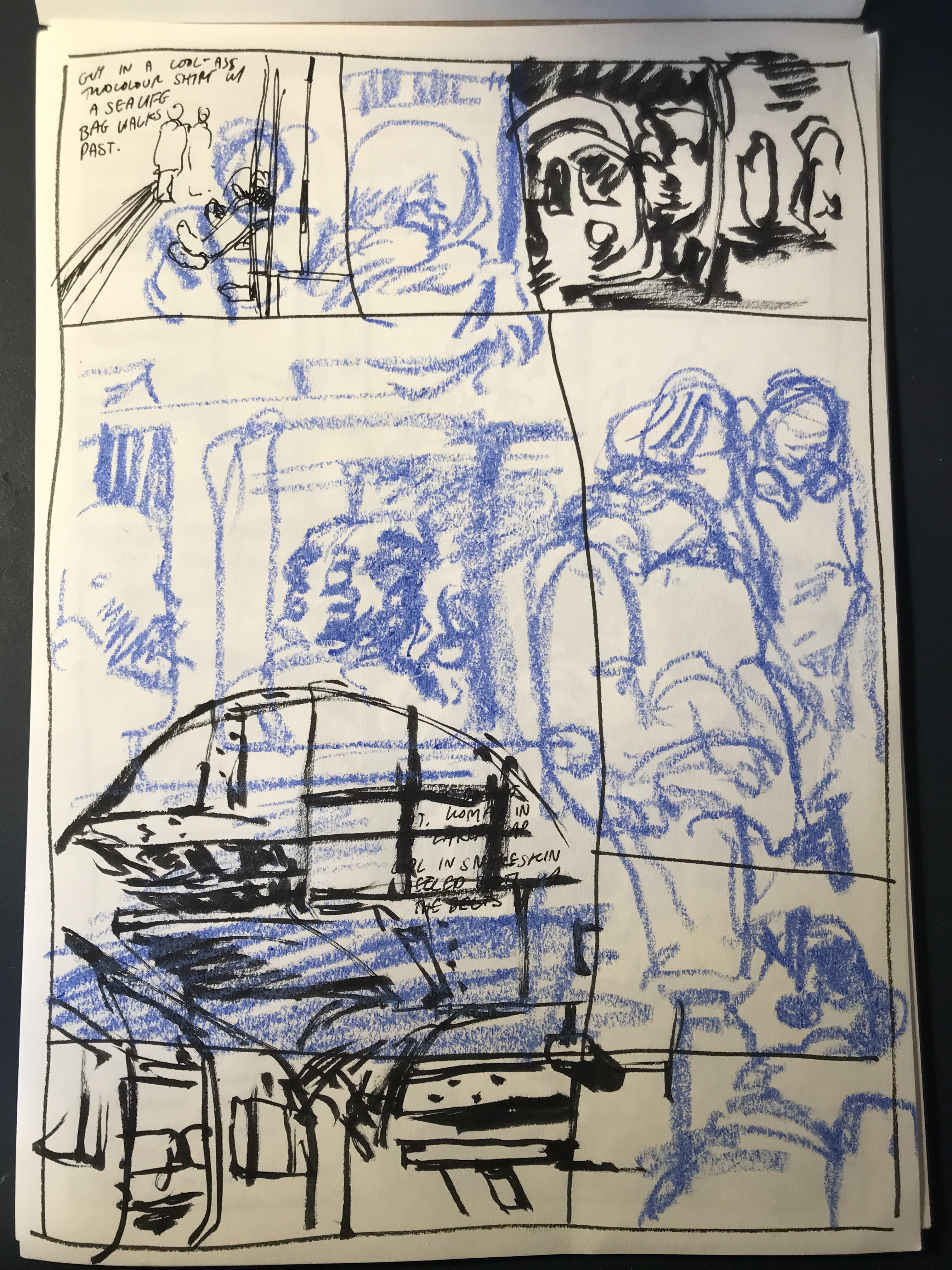
I then went into campus and took some photos of clubbing posters around campus to tie into my theme of Underground. On subsequent train journeys I've been taking photos and collecting stimulus to build from on this project.
Thurs 2nd NovToday I did some more research into Peony Gent's metholodogy for documenting places in her Overlay project, and tried to work towards my own methodology. Next time when I research from life I'm going to spend set amounts of time focusing on one action, like writing down overheard words, or listing who I can see, or trying to draw how I feel, to gather more material that I can bring together.
I also did some more experimental collage-y stuff where I put together words and images I gathered on Wednesday and other images that resonate with me—I mentioned earlier I find the whole Underground system kind of absurd and scary, and what sticks with me is looking out in the dark at the tunnels going by and at other trains, at seeing the lights in the dark from the windows, so I drew from that. These are a bit more surrealist and I don't know if I pulled them off super well but it's something I'll probably come back to.


I'm enjoying the images I'm creating, but I think I want to give it a more thematic bent and involve a narrative. Something that's been bouncing around in my head is this age and layered history that Elephant and Castle has, and one of the notes I made on Tuesday was about ghosts, so my tentative idea is the story of a ghost on the train to Elephant and Castle. I'd like to create a narrative out of the observational drawings and overheard words I've collected to form this almost collaged patchwork story.
Fri 3rd NovTutorial with Eleni went really well. It was nice to see that I'm on track pace-wise and can afford to let off the gas a bit because I have been feeling tired recently. It was also good to talk to other students and bounce my ideas off people, people tended to respond well to what I made and suggest things which was great! Eleni mentioned, in my narrative, thinking about pacing and looping, and how trains run on a schedule and actions are repeated: I think this is really interesting and I could definitely evoke the same thing with repetition and looping story structures, as well as maybe tying in the stamps I was thinking of making, as something repeatable? She also brought up a short animated film (Velocity by Karolina Glusiec, which has similar visuals and also includes very interesting dialogue.
I also read a zine I got at the Anarchist Bookfair a couple weeks ago about gentrificiation in Elephant and Castle, called Poor Fiery Blocks by Christopher Jones, and it was a great read in terms of learning about the history of the area, and also discusses things I was thinking about, like clubbing and also ghosts. The author has a whole series of zines out of the 56a Infoshop, including one about things underneath Southwark, so I'm definitely going to try and read that one, and will probably visit 56a Infoshop in the next week for drawing and researching.
My next steps are going to be the bookbinding workshop, and then populating that book with the comic for the next couple of weeks! I'm fairly enthustiastic about the direction of the project, just tired.
Attended online lesson about preparing the PDF submission for Intro to IVM.
Week 7
Mon 6th NovDidn't do much on this day, mostly wrapping up & submitting work from my previous project. Seasonal affective disorder is beginning to really get to me so I'm struggling with finding the motivation to put pen to paper. Trying to make sure I make good work when I can & don't fall behind. Tues 7th Nov
Bookbinding session as part of the workshop rotation! I've wanted to do bookbinding for a while so I really enjoyed this, I like learning new crafts and I found the process of putting a book together to be very satisfying. I particularly liked the dos-a-dos binding, where you have two books back to back sharing a cover. I think later on in this project, I might explore interesting book arts bindings and layouts to mathc & accentuate my drawings. I've seen a couple of flexagon zines on Instagram recently, which is more of a folded paper situation than a binding: examples by brattyxbre_ and chasc0re on Instagram


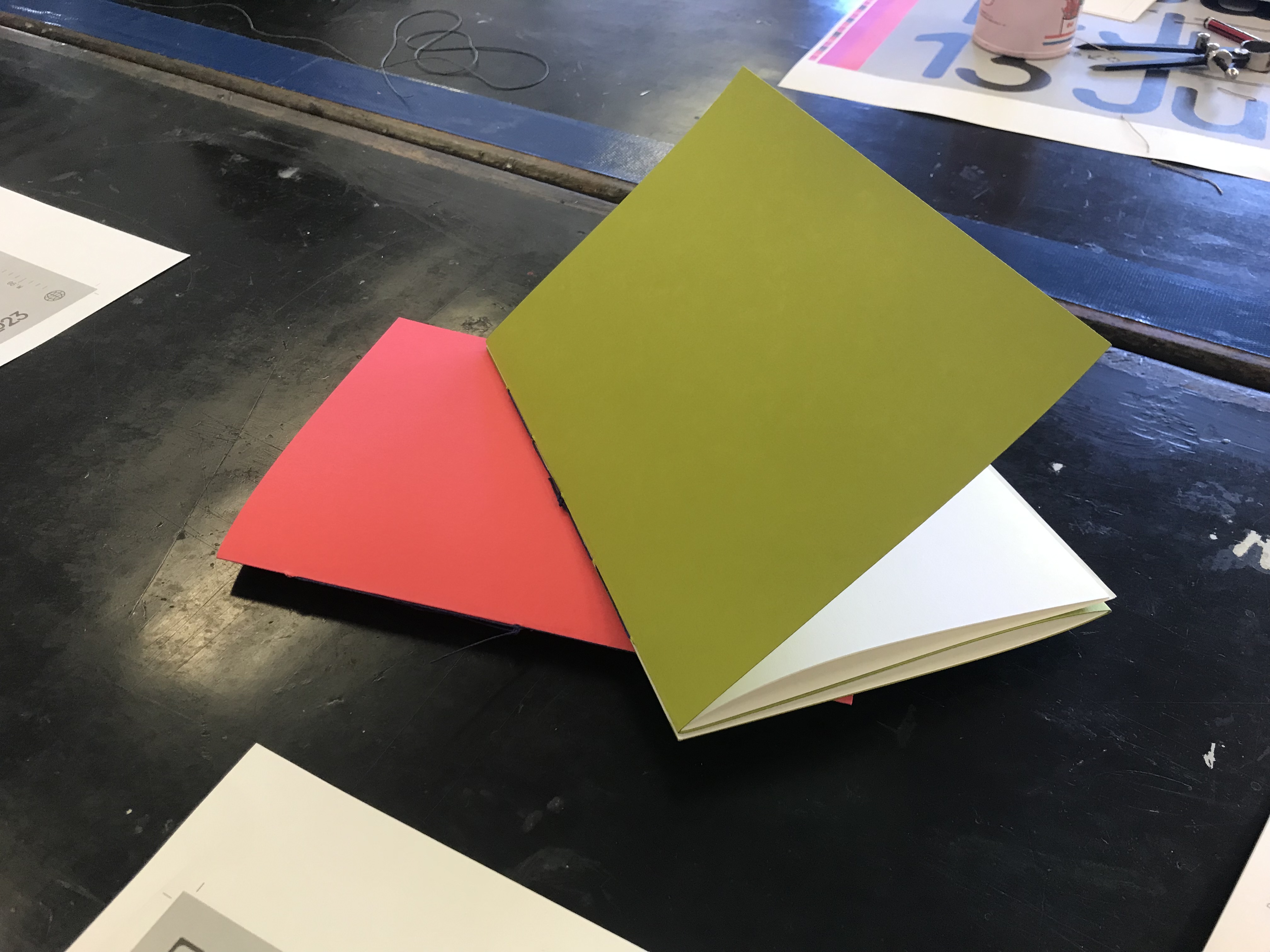
Eleni mentioned in tutorial thinking about looping and timing with reference to trains (trains operating on a specific timeline & loop) so I thought the dos a dos book would be an interesting way of exploring that idea: funnily enough, one of the references Rahel brought up for the dos a dos book was student work of a train journey that can be read either way because of the dos a dos binding! I think that idea is really interesting, so I went into the tube station and started drawing in that book.
I drew in the train station for about an hour, drawing in the same style I was before but also trying to construct this narrative out of it and be more methodical - but I also found it very difficult to keep the idea of the narrative and creating a consistent structure in my head while also drawing from life at a fast pace. As a result, I ended up making some drawings I'm not super happy with because I was focusing on a lot of different things and not feeling like I was doing any of them super well. I also tried some more imagination-based stuff, which I think paid off - drawing how I imagine the ground above the train tunnel, and trying to draw the sensory experience of being on the tube.
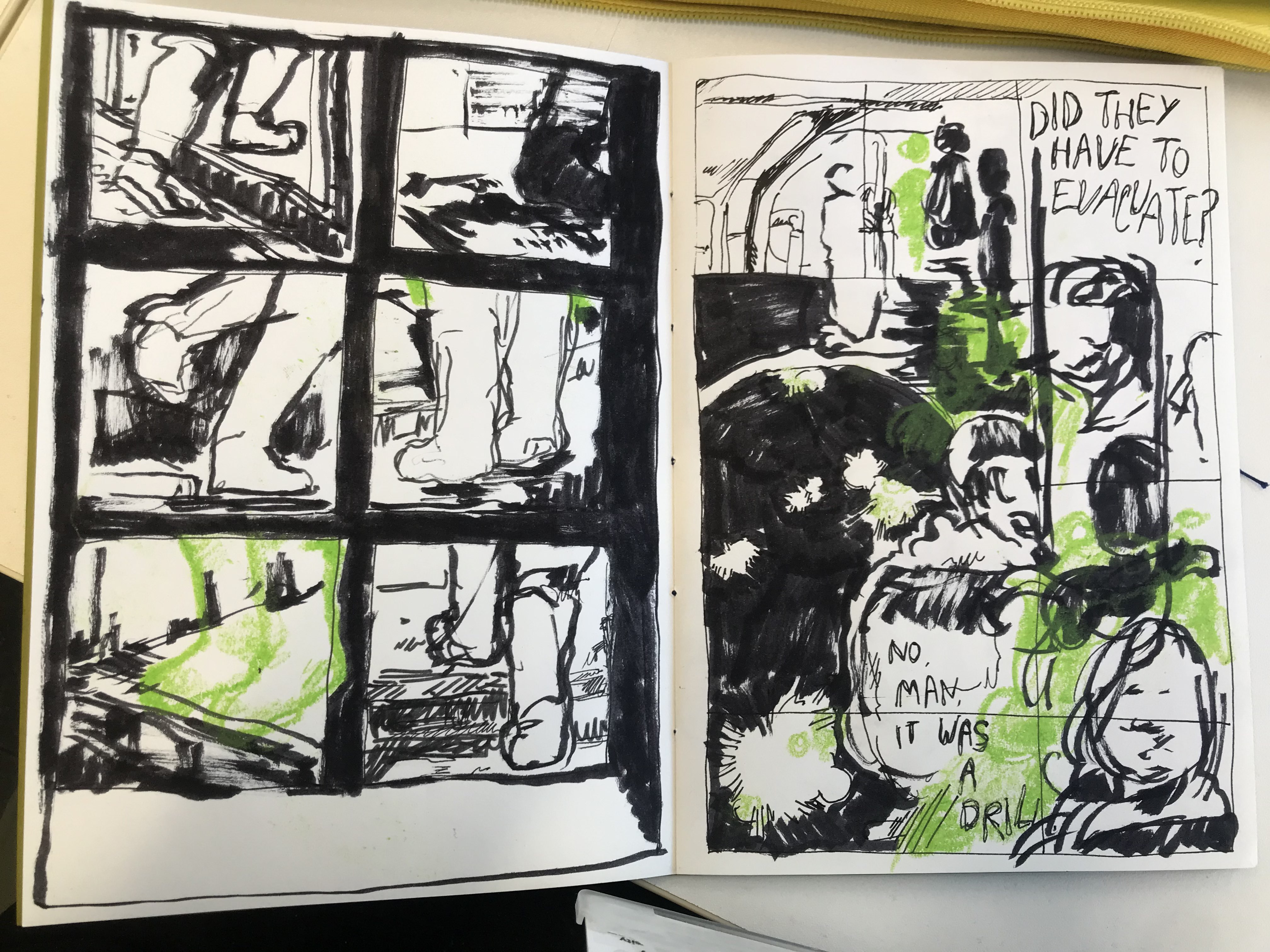


I also had my tutorial with VJ, which went well.
Weds 8th NovAfter feeling unsatisifed with my drawings from the previous day, I decided to try and copy out some of the sketches I've made previously into a comic format, so I'm not dealing with trying to structure a narrative while also drawing from life. I think these came out so well & I'm so happy with them. At the tutorial the day before I showed VJ the work I'd been doing & he mentioned incorporating cutting through pages to create more visual interest and lead between pages, so I decided to do that!
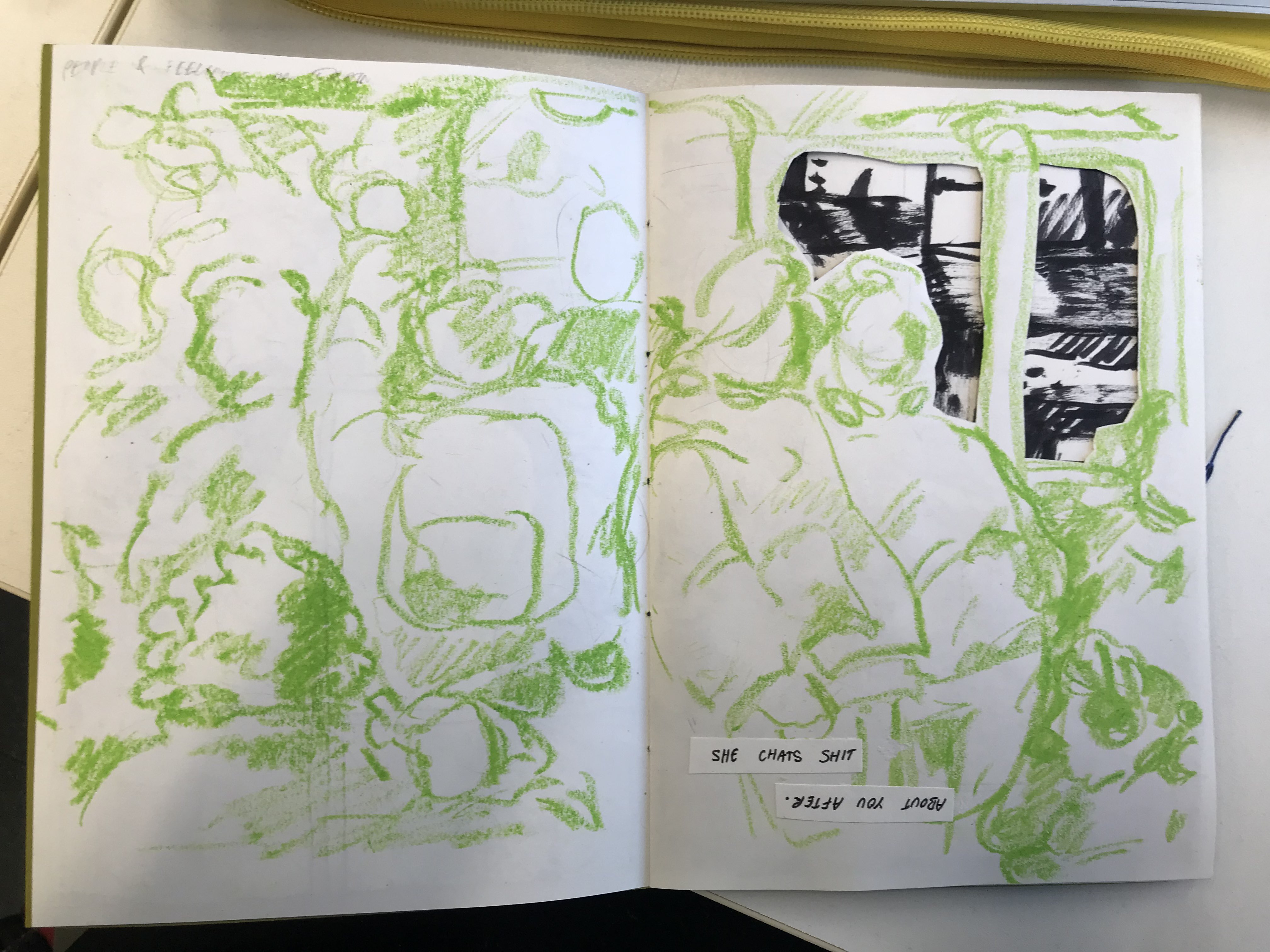
 Thurs 9th Nov
Thurs 9th Nov
I went to the 56a Infoshop on Thursday to try and research more about the history of Elephant and Castle & follow up on the zine I read and see if I can track down other issues of it. I ended up reading about the project to stop the shopping centre across the road from LCC being knocked down, and what used to be in that space. The construction site opposite uni has been a prominent feature of the area to me as I take the Thameslink (which runs right next to it) into school, so it was very helpful to read accounts of the old shopping centre and the community it fostered. I also learnt there used to be subway tunnels in and around Elephant & Castle that were filled in with concrete, which is very relevant to my project about the past and the underground.




Fri 10th Nov
Tutorial was helpful, it being with a new group was a little nervewracking but it's nice to meet new people on my course & see all the different approaches people have taken to this project. I can't lie, I'm feeling kind of upset and disappointed with myself because I feel like I've been working very slowly and not in a productive way. I know it's the seasonal affective disorder, it's just so frustrating. Going forward, I'm going to focus less on filling up the books I've made, because I think that puts a lot of pressure on me to make a polished piece straight out of the gate. We do have a whole curation stage at the end of this project for laying out things in a cohesive and nice way, so for now I'm just going to focus on trying to make interesting work on the A4 sheets and then later scanning it, copying it and arranging it. I also want to incorporate more research and defined methodologies into my work, as I didn't really do that before after getting distracted from bookmaking.
[written 17th Nov] Was feeling in a rut and wanted to try something new. I've found that because this project isn't my normal style, I've been struggling to develop pieces or continue with ideas after I start them, so I've been changing up stuff a lot & trying new techniques when I feel stuck. Today I decided to try flexagons! Flexagons are folded strips and glued strips of paper that can be folded into a flat plane that folds out into multiple different 'sides.' They're hard to describe but they're a mathematical concept that's been around for a while & there's a lot of research around them. I made a trihexaflexagon using this template and this video tutorial, and a hexatetraflexagon using this tutorial and template.
I think these are really interesting ways of formatting comics, especially since they're cyclic, meaning you can start at any point and loop the comic, so trying to take advantage of that format will be an interesting exercise.
Online class with Ching-li. Going to be making sure I add timestamps to this blog going forward!
Week 8
Mon 13th Nov [Entry written Fri 17th Nov]I've been struggling with a lack of motivation recently, so I decided to come into school to do some work in the hope the change of pace and working with a friend will help. I created some ink drawings for my trihexaflexagon, inspired by Eleni's thoughts about timing and looping and trains: three drawings of someone waiting at a train platform that can be looped from any point and in either direction. I also wanted to incorporate colour and the square hexatetraflexagon format, so I did some little colourful sketches with pastel. I think these are less successful (I'm still not good at getting detail in pastel) but I wanted to see how that flexagon shape would look.

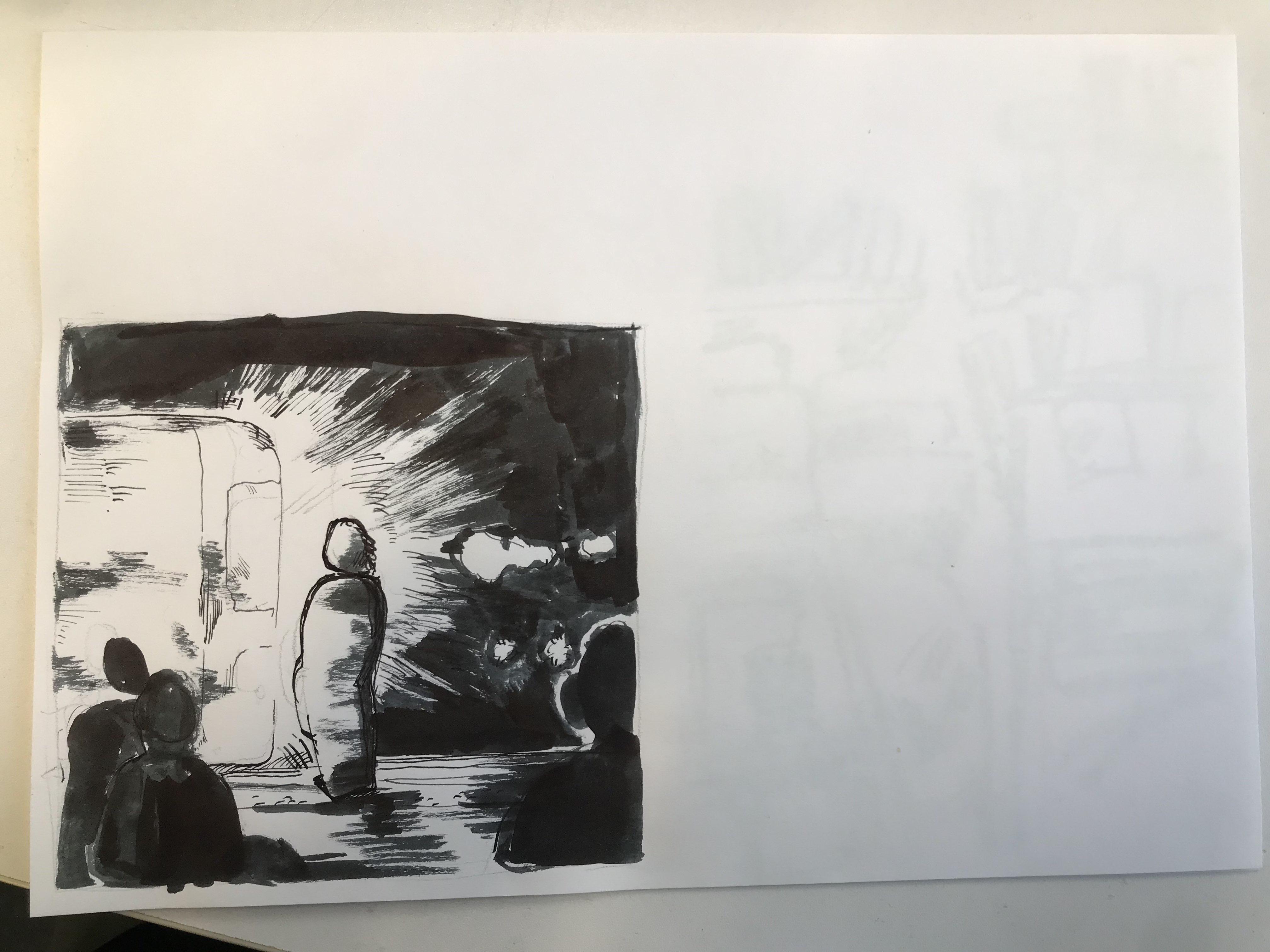
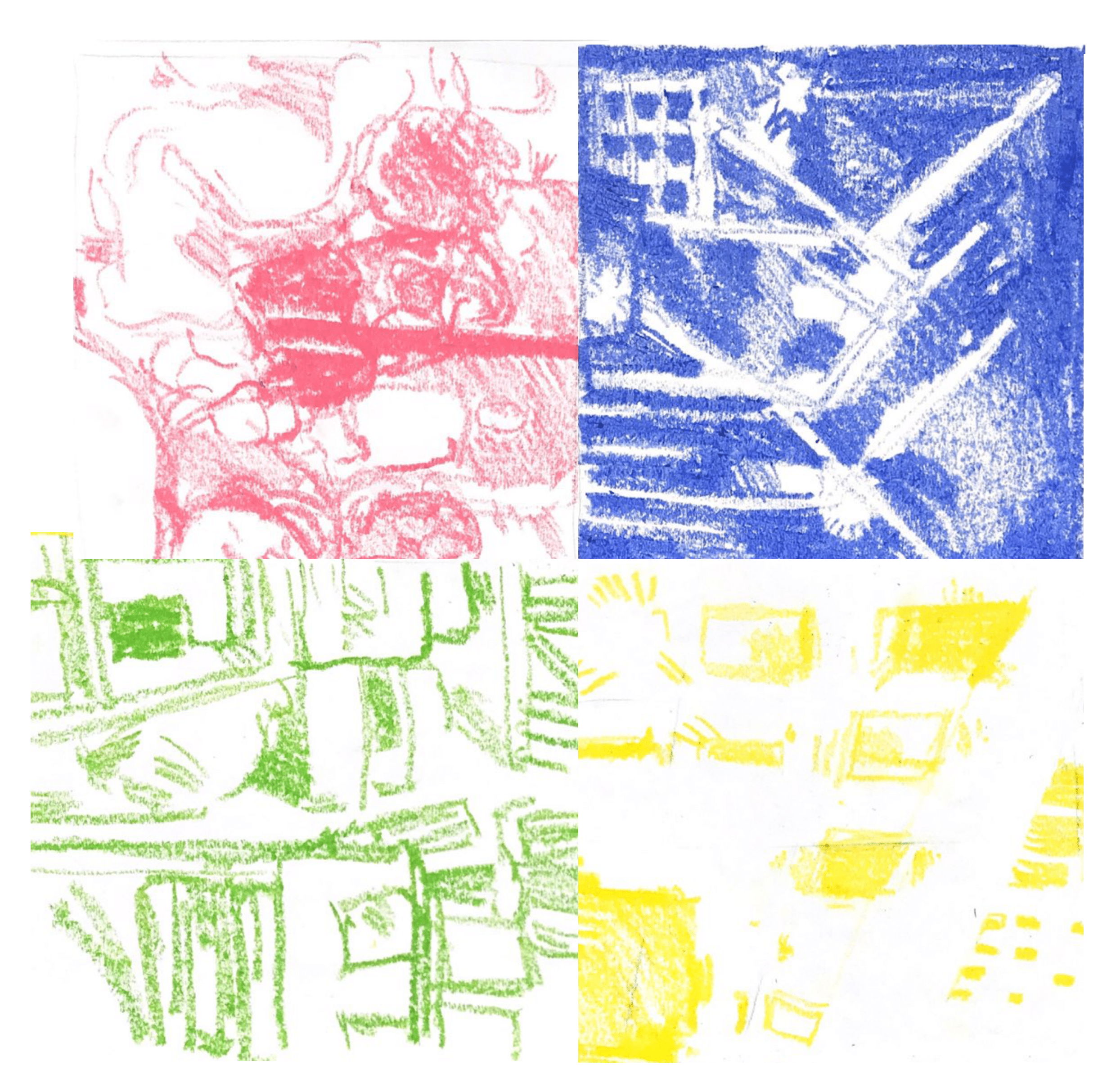
I scanned all those images and tried to create flexagon nets out of them on Photoshop, but figuring out how to do the complex orienting for the trihexaflexagon was really difficult. After struggling with that for a while and taking a break, I decided to fold another flexagon, print and cut the drawings out to stick onto the correct faces, then unfold the flexagon later and recreate that for a proper net.
Here's the first flexagon mockup I made. I plan to make another version of this design on better quality paper with better printing.
Tues 14th Nov [entry written Fri 17th Nov]
British Museum trip! Here are my notes:
It was definitely an interesting experience and inspired me to think more critically about what I present and who I research. I admit, I haven't been interacting with actual people much, honestly, it's kind of scary to me! I'm anxious and I worry that I'll come across as offensive or ineducated, but I'm going to suck it up and try and do some more informed research. I think I'm going to go back to 56a Infoshop, as I know someone there already & can talk to them, and they tie into my personal interests and the themes of my project: things underground and overlooked in Elephant and Castle.
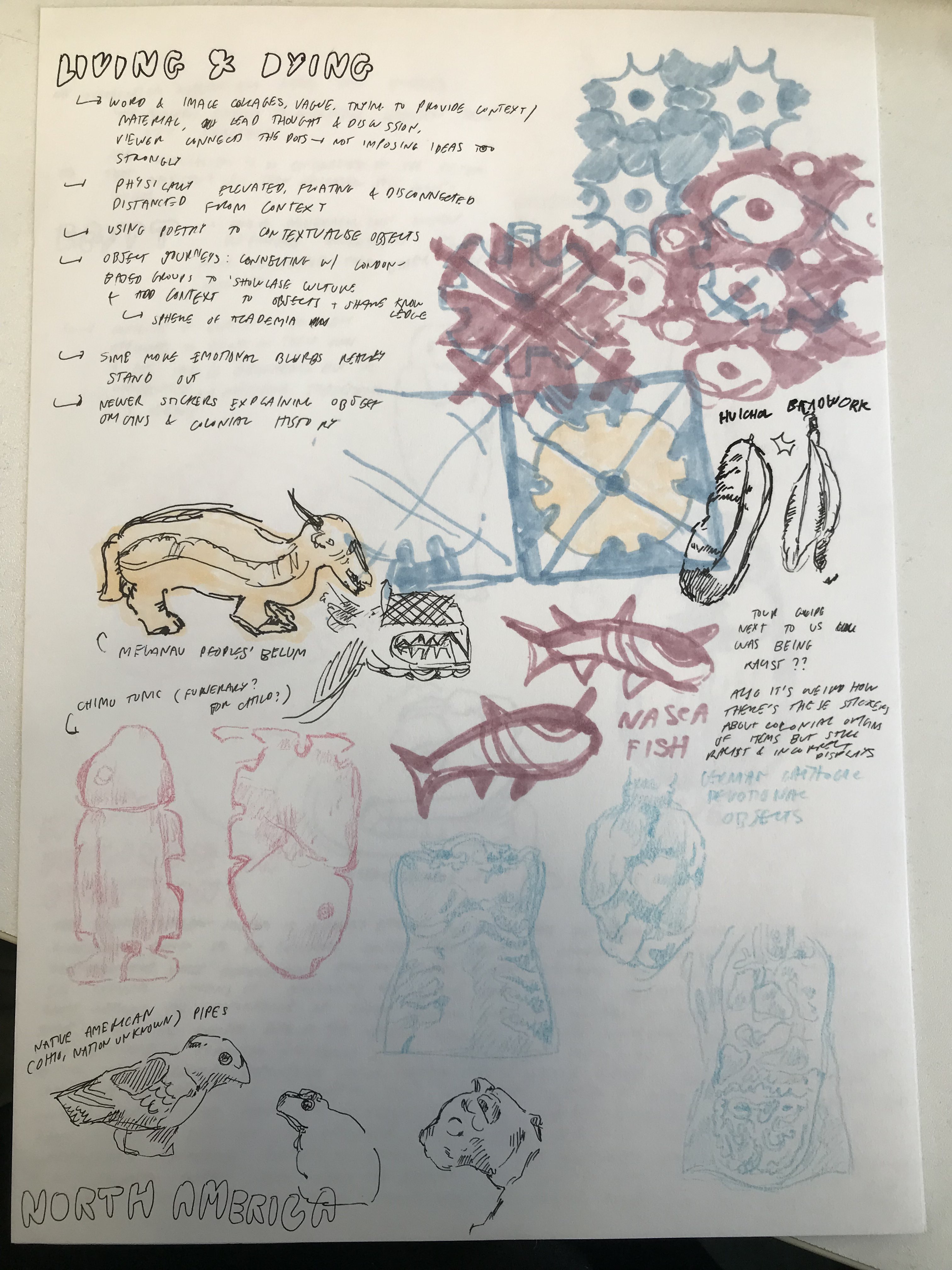
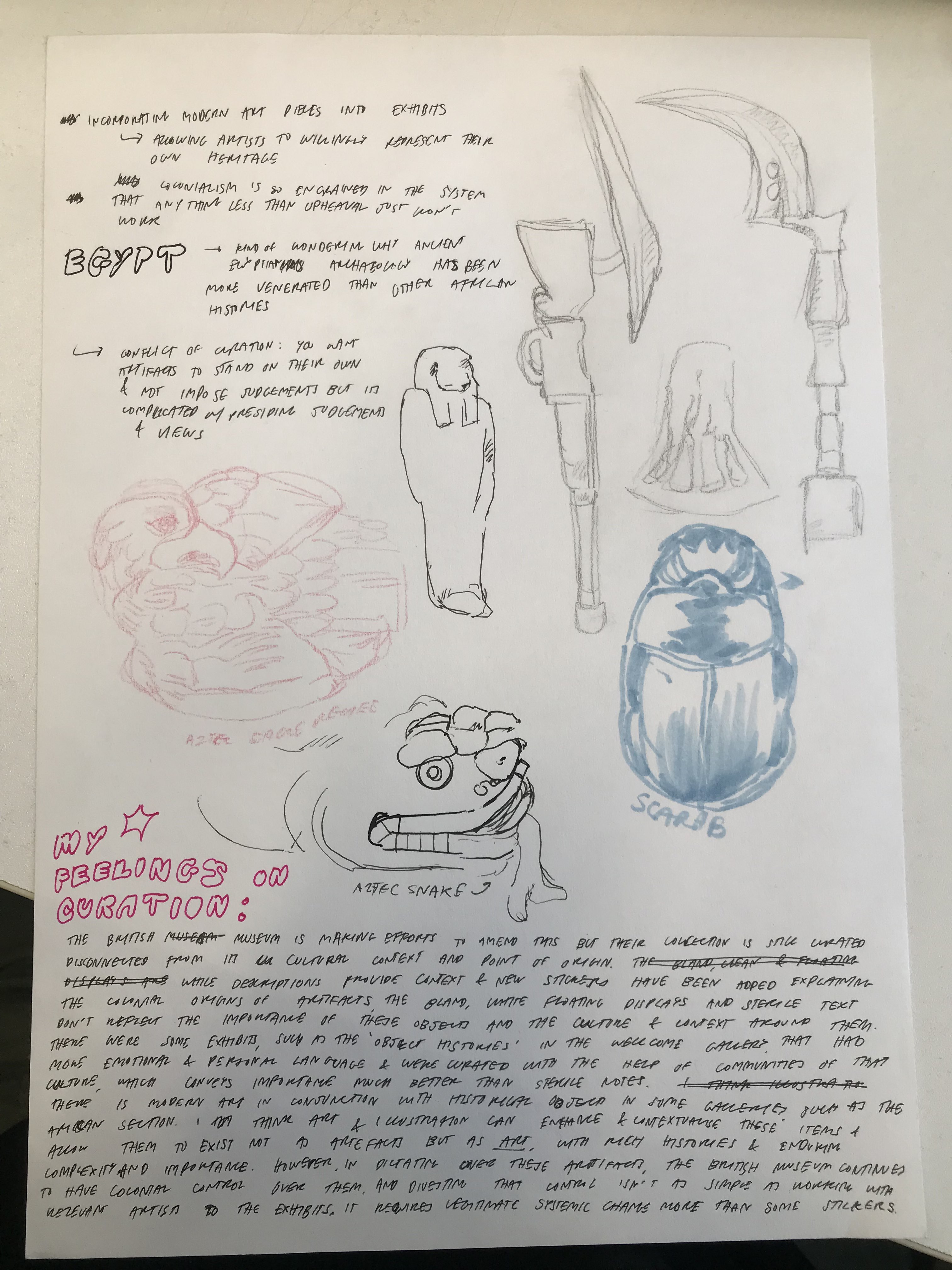
Continued to work on flexagons! Created the net for the final train loop flexagon design in photoshop. These will be double-sided, because I want to use good quality paper, and a flexagon requires folding the whole strip of paper in half, which works with thin printer paper but will add a lot of thickness to a version on nice card, and also can fall apart, so I think double sided is the easier option.
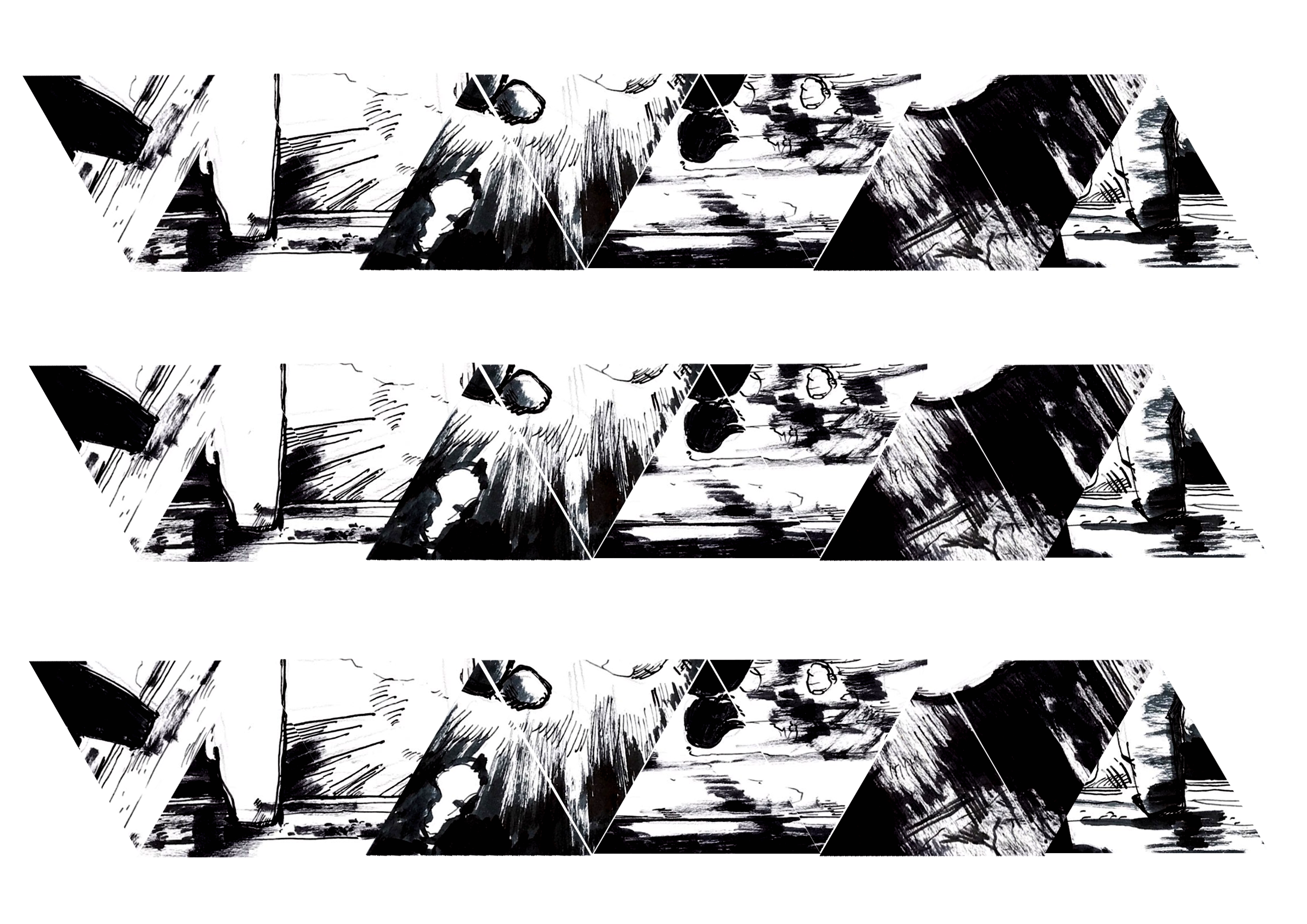

Created this video showing my flexagons and explaining my process and thoughts on them over today and previous days!
Went to 56a Infoshop and Fareshares and talked to the two people volunteering there, mainly about the history of the space, how they operate it, and what, to them, is the thing about that they would like to see displayed or preserved. Took notes about our conversations, and sketches of what I saw there. I also got to see & read about the history of 56a — however most of it is largely unattributed posters/notes/manifestos that I don't feel super comfortable sharing. I also saw some photos of how the space has changed over time and still kept its ideals. I'd like to illustrate these interviews and the impact of 56a and its history in combination with the previous work and style I've been working in.

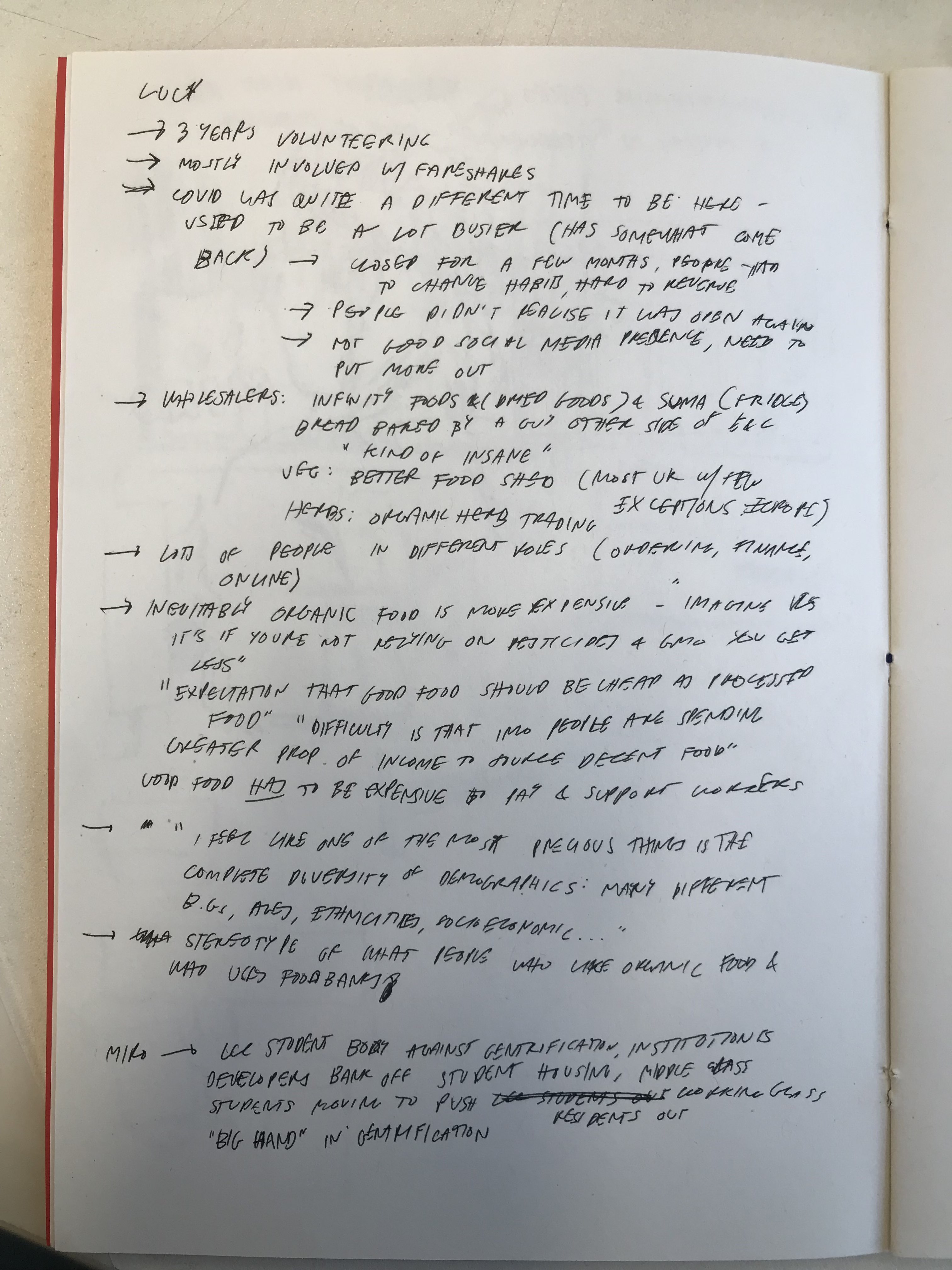

Fri 17th Nov [entry written Fri 24th Nov]
Tutorial was good—got feedback to make flexagons bigger and on better quality material, which I'm planning on doing. Still going slow, mental health and productivity have been pretty low & it's been getting in the way of me for sure.
Attended digital lesson on Photoshop, a program I've been using for years & feel pretty comfortable with.
Week 9
Mon 20th Nov [entry written Fri 24th Nov]Spent the day fixing up to submit my work for Intro to IVM. Booked a tutorial with Adriana (CTS tutor) to discuss it. Procrastinating on my main work somewhat, but I did need to get it done.
Tues 21st Nov [entry written Fri 24th Nov]Type workshop! I found learning about the rules of type and design and how type can emphasize and transmit information really interesting. It's definitely inspiring me to be more thoughtful about how I involve type in my work and composing layout. I enjoyed the tasks of distorting words out of cut text and coming up with creative interpretations. When it came to the task of picking a phrase from our project, I don't think I was inspired as I could be. I could definitely have taken the piece in a more creative direction, but I liked the long folding strip of paper idea. I didn't have the time to make it look like a train, which was the original plan.
Weds 22nd Nov [entry written Fri 24th Nov]
Started on a drawing inspired by my visit to 56a. Wanted to stick to the theme I'd established in earlier pieces with using black on white with coloured oil pastel details. I like this, I think it gives the drawings a grungy, stark feel. I wanted to build on the layout and design information we learnt in the Type workshop, so I created a grid for this illustration and created a balanced composition with balanced colour. I also wanted to return to the Peony Gent-style panelled pages I was doing right at the beginning.
Thurs 23rd Nov [entry written Fri 24th Nov]
Finished off yesterday's drawing about 56a - really proud of it! Think it came out really balanced & looked great. I debated for a long time about whether to add text in the bottom right corner, but I decided against it, because I didn't want the drawing to end up cramped.
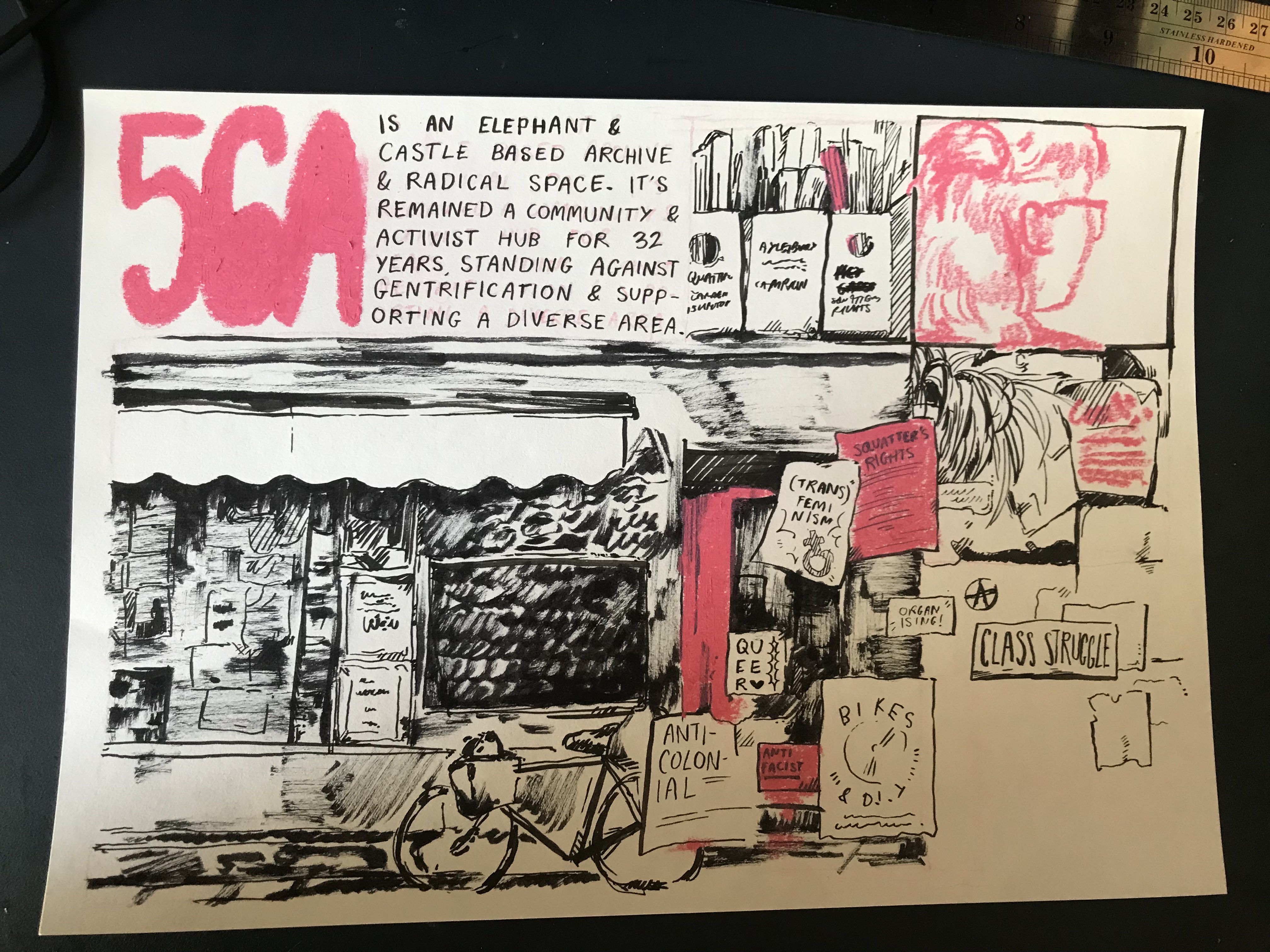
I also started plans for a flexagon of the history of 56a and how it's continued to be accessible and contribute to the community throughout its existence.
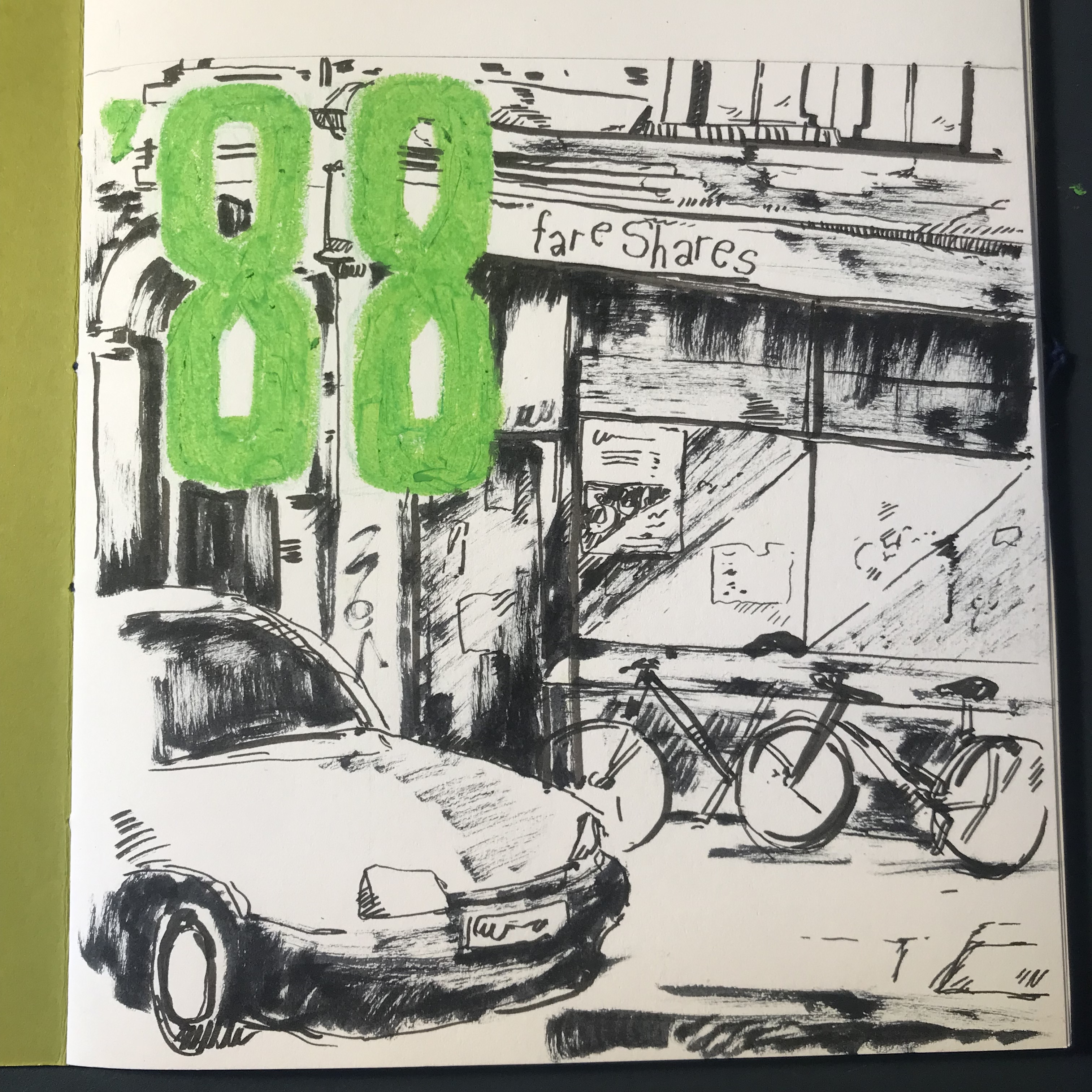
Fri 24th Nov [entry written Fri 24th Nov]
Tutorial with Eleni. Got good feedback, some suggestions I recieved were that my work is very black and white, and I could explore printing my art onto coloured paper and playing with colours I choose. I'd definitely like to try that and see if there's anything I like in it. I also got recommended to print my flexagons out on better quality paper, which I still have not done—the uni printers have been super booked up and I've been far too sluggish to get around to it. As for the 56a flexagon, the critique was that my earlier flexagons have looping element that a flexagon emphasizes, but it doesn't do the same for something like a timeline.
Week 10
Mon 27th Nov [entry written Fri 1st Dec]Frustratingly, I didn't do much this day. mental health still kicking my ass a bit. I went to Life Drawing Society, unrelatedly, in the evening though, and I had a good time there. I'm very out of practise with life drawing, so I was struggling at first, but I managed to keep calm and keep working away at it and eventually made some stuff I really liked!
Tues 28th Nov [entry written Fri 1st Dec]Exhibition-ish thing day! I really enjoyed this day: started it off by talking with my friends about what we made that we liked and didn't. Did the task about photographing your worst work, and analysing other people's worst works. I deciced to do my oil pastel flexagon, since the oil pastel drawings didn't really come out legible at all, but people really liked the folding shape.
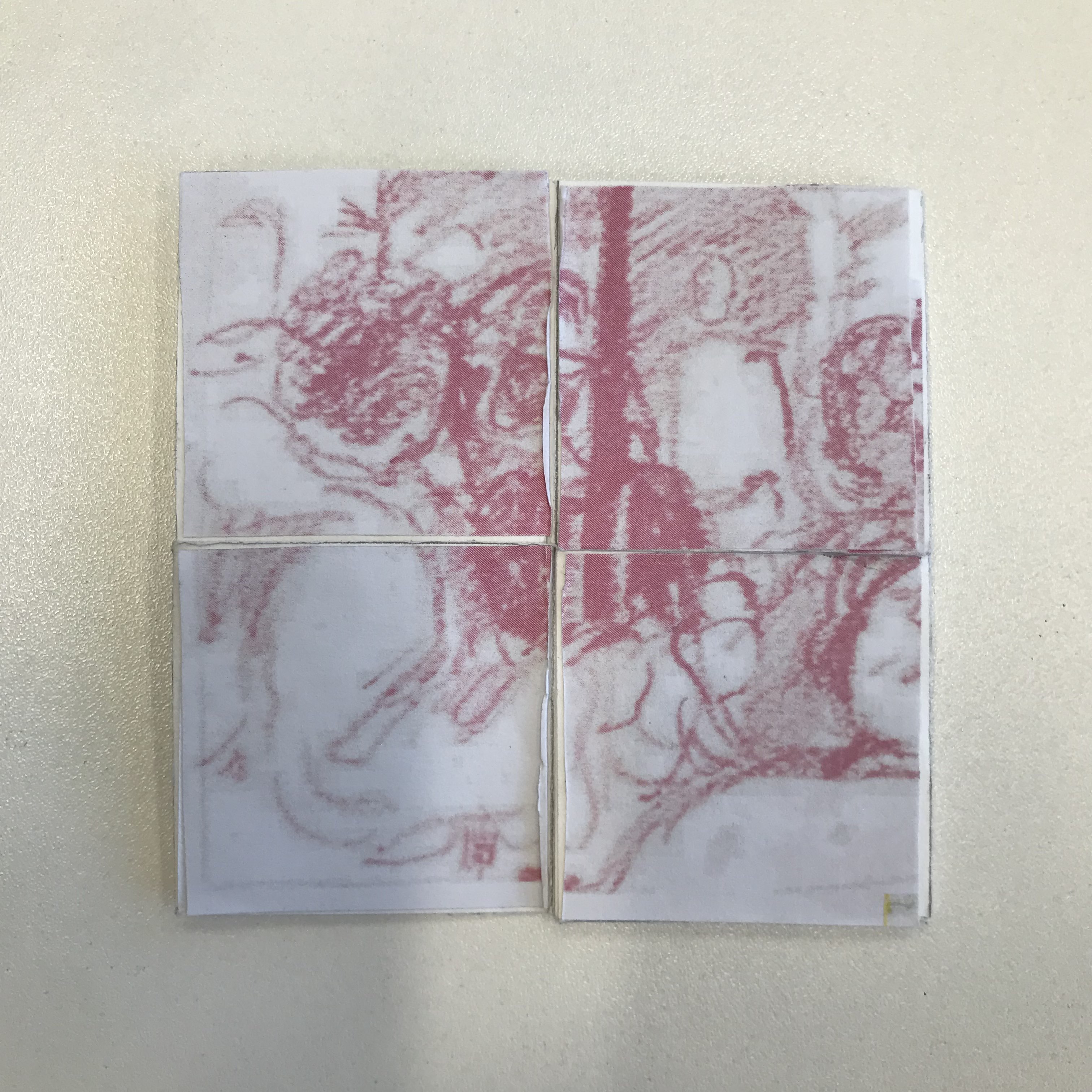

We then laid out our work and walked around, giving critique on post-it notes. I actually really enjoy giving critique to people, complimenting as well as providing feedback I hope is useful, and seeing everyone's work all together and the variety of ideas and interpretations was really inspiring. A lot of the crit I gave boiled down to 'I'd love to see you go further and explore new techniques that might benefit this work' or suggesting people move away from using fineliners. My old tutor on Foundation, Noel, talked about how she didn't like students using fineliners because they're too predictable and they don't inspire creativity, and I definitely saw what she was talking about walking around. Fineliners only really produce one kind of line, and you can do interesting stuff with hatching, but I find that they don't have the unpredictability or movement that other drawing tools have, and this gives them a kind of flat quality. Some of my favourite bodies of work where the ones that looked and felt incredibly cohesive, stylistically and theme wise.
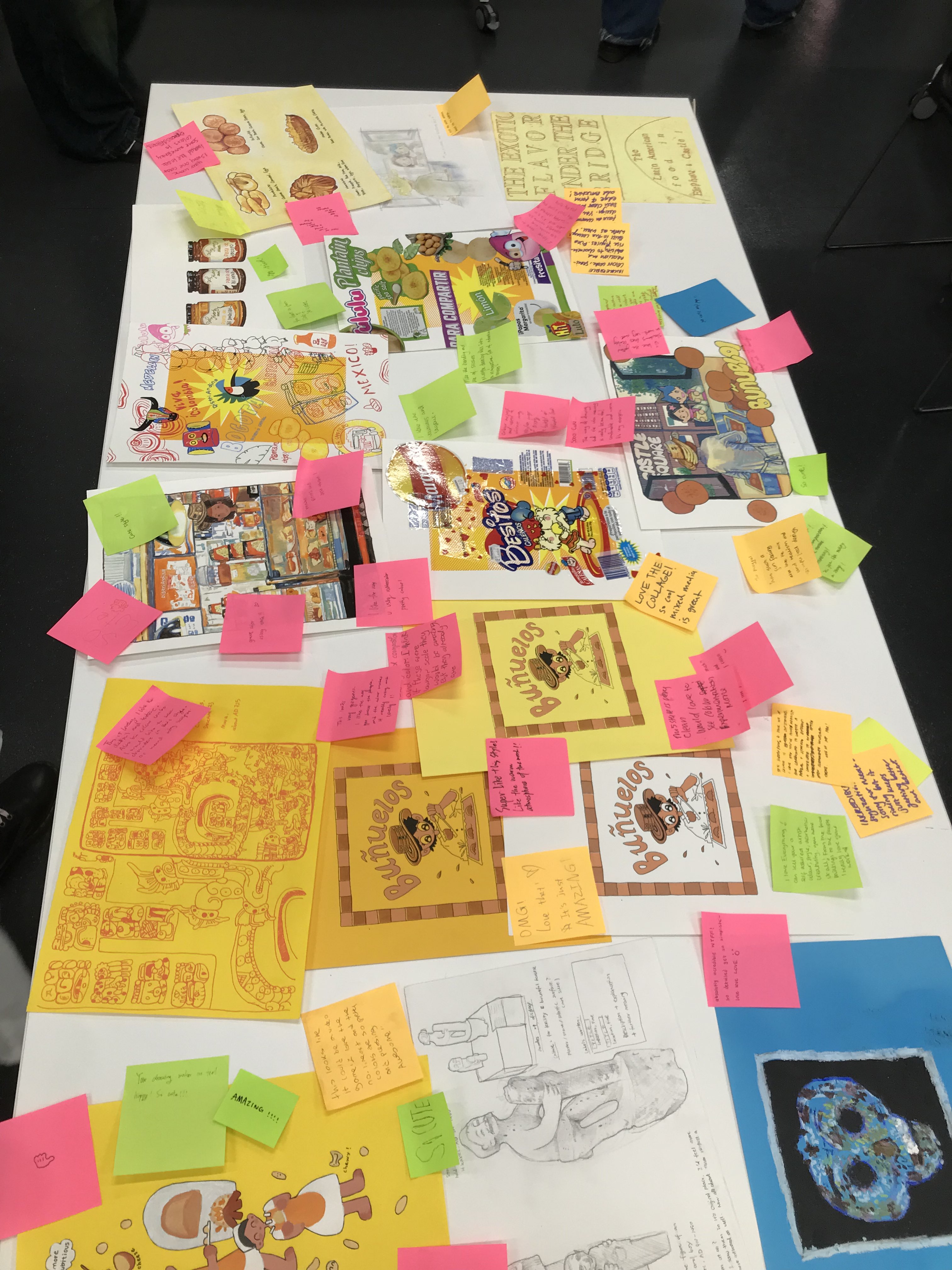


I got lots of really lovely feedback from my work, people seemed to really resonate with the style I used and it got the sensory effect across, which I'm very happy about. People also liked the comic-style composition I used. It was difficult not to compare my work to other people, feeling like hadn't done the project justice or carried across my ideas as best as I could, but a lot of people liked my work, so I feel affirmed that I did well. It was difficult to pick which works to present, since I could only pick three—whether I picked more final polished pieces or earlier pieces that showed progress and style developing. I decided to pick one of my earlier finished pieces (in the sketchbook,) the final 56a piece, and my flexagon, which I didn't get to print out a proper version of, since the printers were down. I thought these pieces represented my style and explorations best.
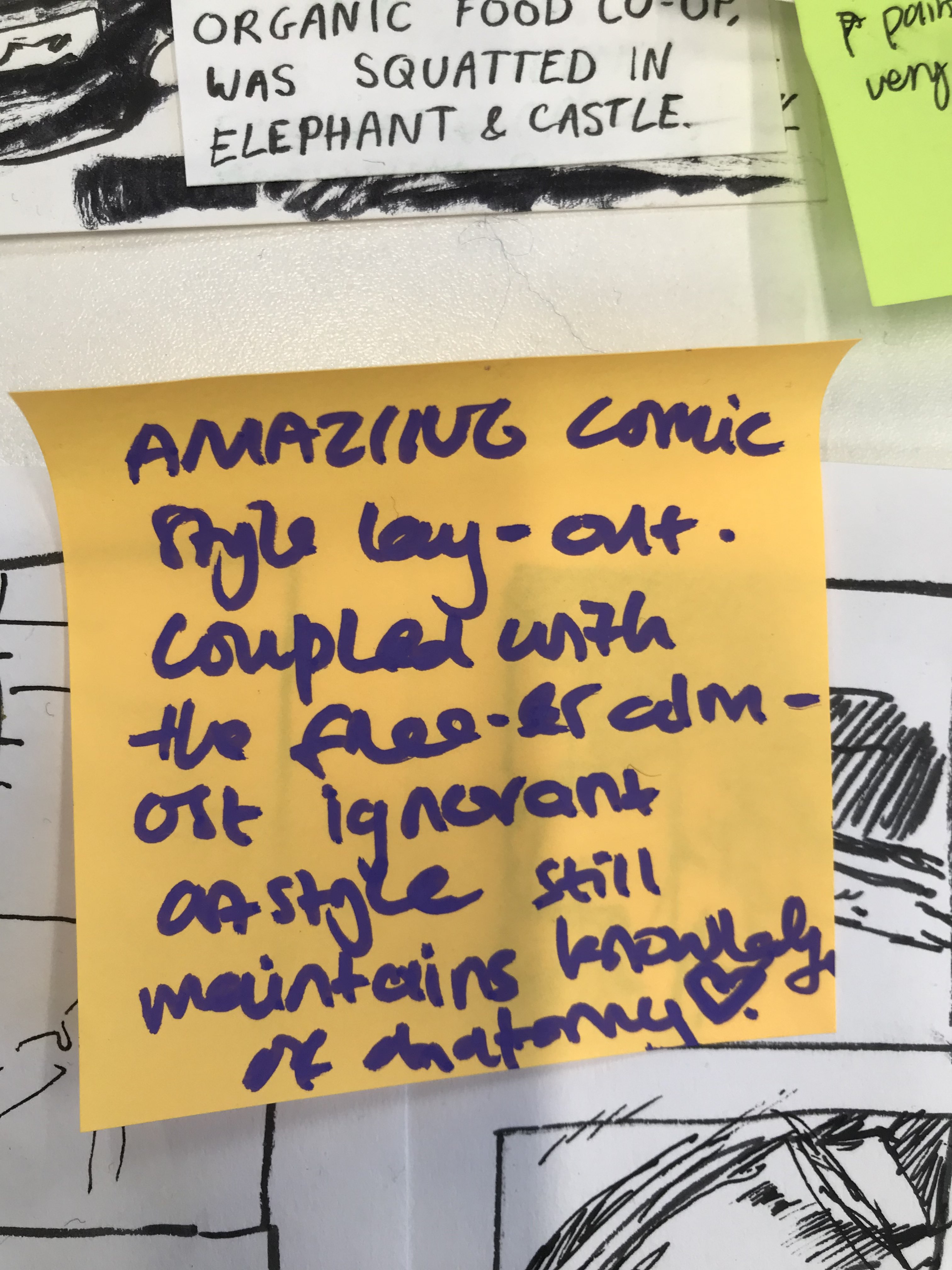


As much as I struggled with it, I am happy with how this project went, considering the circumstances. It's not my normal kind of work, and I've been going through a pretty rough time while it was happening, so all things considered I think it achieved what I wanted it to do, and I'm happy about that. I definitely put effort into trying to work well when I could, set a good work routine and preserve my mental health, and I think it paid off. I'm not sure if I'm going to keep working on this project after the deadline. On one hand, there are unfinished parts that I'd like to finish in order to match the vision in my mind, but on the other hand, I kind of want to just be done with this project. I guess I'll see how it goes! I am very excited for the next project, though. I'm hoping since it's digital it'll be a little bit closer to the kind of art I do for fun regularly.
Layered Worlds
Week 11
Tuesday 5th DecemberGot the brief for Layered Worlds today! I'm pretty into this project—I love science fiction and I've been meaning to get back into the flow of digital art. I did get a bit of new project stress, just kind of overwhelmed with all the options and where to start. I've mentioned before that I find research difficult due to not knowing where to start, but for this project I'm going to try and set myself a big list and range of things to research and research strategies and try and go down lots of different avenues for finding materials to pull from. The two little frustrations I have are 1, I kind of did this projeect or a very similar version in Intro, but also it shouldn't be difficult for me to find new ground to draw from and 2. The project is specifically utopian and that kind of isn't interesting to me at the moment. I guess I'm just not feeling particularly utopic right now. However, I think there are ways to bend this project to be a bit more critical, it's just, I sometimes find it difficult to find the line between 'interpreting the prompt in an interesting way' and 'not fulfilling the brief.'
My initial idea is about robots and how fascinated I've been with them recently. I think my love for robots comes from an 'autistic relatability' place — a lot of robots are clinical and scientific and alien in a way that reads very autistic to me :) I'm also really interested with how social issues and heirachy and oppression interact with robots. Robots often represent dehumanized bodies, people without souls or humanity, and this intersects with oppression + especially labour a lot. I'm particularly interested with how female robots are presented and the intersection of robots and sexism. Robots often act as a way of, in universe and out of universe, constructing a body that's under one's control, the 'ideal' objectified form, and invisiblising labour, and I think this fits very neatly with how women are seen and feminity is constructed—think of, even in the real world, how many female assistant AIs there are, how many sex-bots are proposed, and it shows up even more in science fiction. There's also a Marxist slant to robots I'm interested in, given how 'robot' comes from a word that means 'forced labour.'
As for the digital art, I've recently been feeling kind of out of touch with my digital art—it just doesn't feel as responsive and tactile as my analogue stuff. I'm hoping that I can reconnect with digital art a bit over this project. I think I might be able to fix the tactility issue by trying different Photoshop brushes with more texture and responsivity, or borrowing a screen tablet from the university kit shop to get me to feel more connected with what I'm drawing.
Friday 8th DecemberPut together a list of media/topics/ideas I want to research for this project. I find that doing timetables isn't super helpful for me, because executive dysfunction means time often slips for me, and I'll just end up falling behind, plus I want to do different things depending on my mood, so a checklist works better for me. I'm focusing on robots and how they interact with humans & society.
One of the references Eleni gave me was the Cyborg Manifesto and its accompanying whole movement of cyberfeminism, which I will definitely look into, as well as references to soft robotics and existing robots in the world, like Paro the seal, which relate to how we design robots to be interacted with. This is a big list, and I probably won't be able to cover it all, but it's all topics I enjoy, so hopefully that makes it easier!
Fiction
- Fiction
- Movies/TV
- Blade Runner
- Ghost in the Shell anime
- A.I. Artificial Intelligence or perhaps Her (for how female robots are presented)
- Mech stuff (FLCL or Gundam or Evangelion)
- 2001: A Space Odyssey
- Games
- Cyberqueen by Porpentine Charity Heartscape
- Detroit Become Human
- SOMA
- Signalis
- Nier Automata
- Books
- That zine about cyborgs I bought at anarchist bookfair - write its name later
- Cyborg Manifesto
- I, Robot - Isaac Asimov
- Art/visuals
- Jess Johnson
- Cannupa Hanska Luger
- Non-fiction
- General topics
- Robots and marxism
- Robots and feminism / Cyberfeminism
- Transhumanism
- How art comes into how people design robots/technology (fictional and IRL)
- Soft robotics
- Paro the seal
- Asimo
- Role of robots in our world
- History of tokusatsu design
- IRL use of robots as intersecting with women
- Assistants
- Sexbots
- Sex and robots in general
- AI and art and capitalism
- Specific books
- Chapter in Red Planet (book about marxism and science fiction) about art and utopia
Winter Holiday Research - Dec 8th to Jan 8th
8th Dec - Cyberqueen by Porpentine- I played this game first on the 8th but I don’t feel done with it yet, I need to go through it again and just absorb it and sit with it even more. It’s very violent and very sexual, and I think some people might dismiss it along those lines, but I’m really captivated by it. In some ways it’s a ‘robot revolution’ storyline, the robot taking revenge on the humans who have mistreated it, and in turn subjugating and oppressing them, but there’s also something euphoric and freeing about the revenge and being subjugated in that way. It’s a game very interested in, I guess I’d describe it as bringing ‘opposites’ back together? Repression and freedom (you as the player character become free and joyful through being broken and assimilated), disgust and beauty (lots of references to bodies and fluids that are then eroticized), violence and love. I think it’s kind of impossible to talk about without talking about the creator being trans, and the transformation within the game, the dynamics of freedom and oppression, and violent revolution, and blending both of those with sexuality and fetish content. There’s a whole jumble and mine of themes here I don’t feel like I’m quite comprehending, I’m just seeing this rich messy surface.
10th to 14th Dec - Pluto - Urasawa x Tezuka
- I was actually planning on reading this anyway before I even started this project. Artistically, it’s fascinating: Naoki Urasawa, the manga artist, is utterly fascinated by depicting the human face, with micro-expressions and details not normally seen in stylised comics, so it’s fascinating to see how he tackles robots. Almost all of the robots in Pluto are inexpressive (apart from Gesicht), but the art still focuses on their faces a lot, which gives it this almost haunting quality, you really feel the lack of expression. I’ve only read the first volume, so the story hasn’t really got going, but I found myself feeling a huge amount of empathy towards the robot characters (probably because the narrative conceit basically dooms them all to die) but there was something so moving about how these robots were feeling human emotions, assimilating into society and even working on art. So far, it’s a fairly straight noir, but I’m only on volume 1, and I don’t know if I’ll have time to read the others.
12th Dec - R.U.R. (Russom’s Universal Robots) - Karel Capek
Read translation by David Wyllie (accessed here) , watched Battle Damage Theatre production on YouTube (here)
- R.U.R. is the work of fiction that invented the word ‘robot’, from the Czech word for ‘forced labour.’ It’s from 1920, and despite being over 100 years old, the thing that shocked me was how consistent the conversation about robots and automation has stayed. From the general fear of being replaced and thus having no purpose or meaning or people to dominate, to the desire for a utopia achieved through succeeding in capitalism, to people turning to religion when threatened or avoiding inconvenience even if it's the end of the world. I find it very hard not to think about the robot revolution from an anticapitalist perspective—the way the robots' creators, and then the robots all want to achieve freedom by picking or making other people to oppress. The conclusion of 'the robots are humans who feel love and emotion' is now overplayed but does get pulled off well here, carried by how emotive the writing is. I'm definitely going to research more whether these tropes come from R.U.R. or they were pre-existing, and the wider history of fears about the machine revolution, I don't quite believe that there could not be a long trail of people being scared about this exact same thing. But still even from this moment the robot is super tied up in themes of oppression and subjugation. I think there's also something to be said about women in the play, how all of the male humans obsess over Helena, the existence of and the way people talk about robot helena... there's a lot of little moments in this play I'm still stewing over.
18th Dec - Art as ‘the basic technique of life’- Utopian art and art in utopia in ‘The Dispossessed’ and ‘Blue Mars’ by William J. Burling (part of Red Planets: Marxism and Science Fiction)
-
(summary) This essay discusses how art about utopia is necessarily about what art would be
in
utopia. It uses Bertolt Brecht’s concept of the apparatus, the environment within which a work of art is created, to describe how art in our world is constructed as a commodity, and that nature of commodity defines what it can do or be. Utopian art should be disconnected from our modern apparatus, and not a commodity, transforming how people interact with art and making it possible for anyone to engage and create. This is difficult to imagine, because we might be unable to see beyond the constructed world of capitalism, which makes utopian art so difficult to grasp or create.
This essay isn’t related to my theme but is related to the project in general, and inspires me to think about how I can make my art utopian. I definitely feel the conflict between art as a commodity and art as freedom and expression.
19th Dec - The Limits of Utopia by China Mieville, published in Salvage
(summary) This essay describes how utopia can be a neutral but useful tool. Many people have written utopias, from fascists to the billionaires of today (who may be living in utopia), and they reflect people’s desires—but without actual movement, they can function only as ‘valves to release pressure’. Utopia is a process of making. Ideas of unity and utopia can often deceive us, when we’re not all in this together, when we don’t all have the same goals in mind. Bad hope, bad pessimism, both are unhelpful, we must work to construct and dream meaningful utopias instead of imagining collapse instead.
This essay is short, but I had a good time with it, there’s some tricky language, and perhaps not super relevant to my project but good to read, because I really enjoy China Mieville’s fiction and non-fiction.
Various days, it took a long time - The Cyborg Manifesto by Donna Haraway
(summary for my own comprehension) This is an essay where Haraway posits the cyborg as a way of existing that breaks down and melts boundaries, and applies this concept to socialist feminism as a new way of thinking. In capitalism, we can only see boundaries, borders, aggression, domination (hence we see animal/robotic as a strict boundary, like male/female, and robots are often seen as a threat to humanity), but as the world progresses those dichotomies are revealed to be less and less true. Feminist thinking in the capitalist world still flows along these lines and along these boundaries, creating solidarity in identity and sustaining dynamics of domination. Cyborg feminism would step outside these boundaries and work together on affinity, not strict identity (as that doesn’t exist and is counterproductive for the feminist movement.) Affinity is important because all identities are constructs, none exist organically in the world in the way they are now, they exist for political and social means. Feminism must seek to exist outside of the capitalist colonialist world instead of replicating it. Other points: Society has moved from an organic to a technological justification for domination and oppression. Good feminism can’t consider women as something organic and innocent, because that erases womens’ capacity to be agents in domination of their own and the way the category of ‘woman’ is built to uplift white women at the expense of all else.
I found this essay a difficult read. It’s incredibly poetic and dense, and references a lot of other theory, so that I don’t quite get a lot of what it’s referencing. What helped was reading the Wikipedia summary first, which gave me a rough idea of what the points being made were (since the abstract wasn’t very helpful) which meant I could parse the actual sentences better. I’m super interested in what it’s got to say, I generally agree with the political points, and I think the framing device is incredibly potent. It talks about boundaries and permeating them a lot, which is interesting in the context of our assignment, about ‘interior’ and ‘exterior’—I wonder how I could translate Haraway’s cyborg theory onto that boundary. I’d like to then read some of the responses to the essay (the Wikipedia page mentioned criticism by disability activists, and I think disabled voices are super important in talking about cyborgs and robots considering how technology is used in disability care), and about wider cyberfeminism and transhumanism movements.
Transhumanism: “The World’s Most Dangerous Idea” | Philosophy Tube by Abigail Thorn
Watched on YouTube
This is a communicative video essay, designed to educate the viewer on a topic and use philosophy to unpick it, and as such it’s more easily comprehensible than some of the other academic writing I’ve read for this project. Thorn’s style and goal is to teach philosophy skills that people can use for understanding the world better and picking apart people’s views; she achieves this through including skits and scenarios in her videos as an exercise for the viewer to criticise and pick apart.
This video uses transhumanism as an example to cover the social influences of technology and thinking critically about how we use and deploy technology. She uses Heidigger’s philosophies (while being very aware of Heidigger’s Nazi beliefs and how he used philosophy as a tool for his beliefs.) She describes how technology comes with values and ways of seeing attached, and can facilitate new interactions and shape possibilities, but as we use technology, it can seemingly disappear to us. - ‘withdraw from our attention.’ Thorn describes how even social ideas can be technology, and the technology of ‘progress’ and ‘transhumanism’ can disappear from view, when it’s important to keep it in view to understand what values it holds and why those might be problematic—specifically pointing out how focus on progress can lead us to view the problems in society as strictly technological instead of political or social.
I found this refreshingly easy to follow, since it’s aimed at people without philosophy experience and I’ve followed Thorne’s work for a while. I was particularly interested by the idea of technology forming compound entities (her example is a person with a hammer becoming ‘a hammer person’ and interacting with things through the hammer) and Donna Hathaway’s essay, and how robot/cyborg themes have this fear of melding, blurring, making differences undefinable—I think that’s something I’d like to draw on. How technology becomes invisible, embodiment, cyborg stuff, it’s just all very interesting to me.
Robots and Art: Exploring an Unlikely Symbiosis, essay collection edited by Damith Herath and Christian Kroos
Accessed through ProQuest via the UAL library
Chapter: The Art In The Machine by Christian Kroos
This chapter talks about how robots, even when used as tools, are always surrounded by these themes of autonomy, personhood, embodiment, even when they’re simply tools. This is unlike most other technology used in making art—not much photography is about cameras, but most robotic art is about robots. The technology doesn’t disappear (linking back to Transhumanism video essay.) It also posits that androids (robots that resemble humans) are expected to be as close to human as possible, but less human robots have more freedom and exploration in design, as they’re not being measured against a specific thing. Further, robot/human interactions are so complex and granular that they’re hard to analyse scientifically, because everything affects the situation and there’s so many factors. Thus, Kroos posits that art is a unique way to explore what science might not cover, especially in the case of robotics.
Chapter: We Have Always Been Robots: The History of Robots and Art by Elizabeth Stephens and Tara Heffernan
This chapter details the history of automata and robots for artistic purposes, and how their changes have reflected changes in society. Early realistic automata came at about the time of the Enlightenment, when the debate about whether the human body was purely mechanical or had some sort of ‘vital’ spirit raged. It quotes historian of science Jessica Riskin, that robots ‘dramatized two contradictory claims at once: that living creatures were essentially machines and that living creatures were the antithesis of machines.’ (They also note that the technology established in these automatons later came in use for industrial purposes—this is interesting to me, as it reflects how technology used for leisure such as video games is then repurposed in war, specifically.) I also find it very interesting how early automata specifically made art, played - it parallels our modern AI debate.
The essay recounts how the development of Fordist assembly line, and growth of capitalism and industrialisation over the Industrial Revolution provoked change from the early artistic 'automata' to later 'robots' - labourers, as established by R.U.R. Instead of robots emulating the human, humans are now forced to emulate robots. Later robotic artists have played with this dynamic, Jean Tinguely creating robots that drew, but automated the drawing process as if they were on a production line, and Stelarc using robotics to give up control of the body and expose the idea that human autonomy is not as simple as it might seem.
I really enjoyed reading this chapter in particular, the point about how robots changed after the industrial revolution made a lot of stuff click into place for me, and I’m going to follow up on some of the artists mentioned, particularly Stelarc, I think his work plays into the themes established in Cyborg Manifesto in an interesting way.
Embracing Interdependencies: Machines, Humans and Non-Humans by Amy M Youngs
Youngs discusses how her own art practice seeks to explore and reframe our relationships with the environment. She states that humanity has changed and controlled the environment to cater to us, instead of existing as part of the environment, it is something we are above and it can be sold and delivered to us. Youngs creates self-sustaining ecosystems that place humans in different roles using robotics and technology.
I think her work is interesting, and her points about the environment are cogent (it’s important to consider ourselves as part of the environment, and not think of technology as the polar opposite to nature), but her work doesn’t interest me all that much.
I wanted to read the rest of this book, but I’ve been pretty tired & busy lately.
Design Strategies for Representing the Divine in Robots by Gabriele Trovato, Cesar Lucho, Alexander Heurta-Mercador, Francisco Cuellar
Communicating with SanTO - the first Catholic Robot by Gabriele Trovato; Franco Pariasca; Renzo Ramirez; Javier Cerna; Vadim Reutskiy; Laureano Rodriguez; Francisco Cuellar
I mostly clicked on the first paper in this list because I was fascinated by the concept, and how almost sacrilegious it seems, and hunted down the followup paper later. It’s published by human-computer interaction researchers, most of whom who have a couple other articles through the IEEE, so I don’t doubt it’s official research, even if, as the second paper alludes to, it’s fairly fringe.
Some of the paper is design strategies, such as using skeuomorphic design (design that uses elements people recognise for similar purposes to make tools easy to use, such as drawing tools in software being represented by a brush or pen), and the possibility of using these robots to reach to elderly people, using the cultural connection of religion to deliver automated care that elderly people aren’t opposed to. A lot of the rest of the paper that’s not design is about rebuffing the ethical issues behind this and justifying why and how divine robots can help people.
The first paper mentions how historically, automata have been commissioned by the Catholic church as to evoke wonder and awe and show something that can only be made possible through religion. Robots can be argued to parallel the divine, as they are threatening and awesome, can be seen to contain both the apocalypse and the eternal. It also states that ‘without a coherence of behaviour and without displaying superhuman capability. Believers do not expect a human-like communication, and give their own interpretation to a sub-human behaviour or to even a total absence of reaction.’ Although the robots may appear uncanny (the paper specifies they must resemble living things, or be wholly unliving, anything else may be too uncanny), human mysticism and belief will bridge the gap between the robot and the divine presence it aims to resemble. It also drops the incredible line ‘Since the 18th Century, robots have associated less with faith and magical symbolism, and more with efficiency, as the power of creation has shifted from gods to humans’ which is a kind of fascinating way to rephrase the ‘Fordist assembly line’ thing.
Blade Runner dir. Ridley Scott (2007 Final Cut)
Accessed through Box of Broadcasts
I’m left with this feeling that I’m just not quite grasping something about Blade Runner. I’m not sure if it’s that I struggle to follow films, and a lot of the character development felt slightly like I was missing bigger pieces of the puzzle—I wanted to have more time in this world and learn more, but beyond that, I’m still piecing together metaphors that are sticking in my head. Fundamentally, it’s the key robot story, going back to R.U.R.: the conclusion that the boundaries of human and robot have dissolved, and ‘being human’ is a meaningless category. I think there’s more ambiguity, though—whether someone is a replicant is decided by evaluating their emotional reactions and abnormal physical reactions (as in I, Robot, there’s a psychological element to the robot/human divide and what’s considered deviant) that relies on what’s considered abnormal. Although it’s not explored in the film, this idea of defining abnormality (especially emotional) w.r.t robots seems to crop up a lot, and as an autistic person it’s something I’m super interested in. I know Rachael’s existence is that because she’s such an advanced replicant model, she doesn’t know she’s a replicant and thus feels as though she’s completely human, but looking at it from another angle is super fascinating to me—does Rachael not appear as a replicant because she doesn’t believe she is, further muddling the human/robot divide and making the matter of it far more social and perceptual?
There's also the, and this is the thing I’m stuck on—the animal thing. Related to the previous point, when Deckard does the test on Rachael, the questions relate to killing or eating animals, and some of them she seems very against the prospect and some of it instantly for—a musing on what it’s acceptable to kill, as Deckard has to decide. However, there’s this thing about all the animals being fake, robotic, and then how Roy begins to act animalistically in the final fight scene, it’s just… there’s something there.
other miscellaneous thoughts:
The colour in this movie looks amazing. The heavy noir influence lends itself to chiaroscuro and heavy stylization of colour and light. I find colours on film to be far more impactful and rich than colours shot digitally—I think it’s something about film having less verisimilitude, it feels more than it looks. Like in animation, you don’t represent real motion, you represent the motion that it feels like.
I get why the tears in rain monologue is so beloved. It’s great.
There’s a lot of cunty incredibly large collars in this movie. They really committed to the collars
Everytime I watch a movie with Harrison Ford in, if my mum is there, she points out that he does a ton of acting with his hands, and if he’s in something, there’s going to be a scene where he’s struggling to grab onto something or scrabbling around. This happens in Blade Runner too
The basically rape scene is interesting if you think about Rachael as an exploited party basically having other people’s thoughts and feelings foisted on her again but I don’t know if that was the genuine intention or if it’s just oh cool, a rape scene.
I Robot, by Isaac Asimov
Read through local library
This book took a very long time to read, because I haven’t been getting much time to read in the evenings due to the Tired Disease (depression.) It’s framed around psychology, which is intriguing in terms of how we usually conceptualise robots, but if you have even the slightest criticism of how psychology operates in the modern world, it’s an… interesting read. I talked about how Blade Runner’s replicant concept hinges on determining abnormality through psychological means, and I, Robot operates in a similar way: it’s all about deviation from the psychological norm, and that being unacceptable when robots are used for efficient labour. I think some of the conundrums brought up with how robots operate within the 3 Laws of Robotics are very interesting, but I don’t know how much it had to say about robots as a wider issue. It’s very unchallenging of their place in the capitalist ecosystem in a way that can read as quite worrying. Towards the end, the book posits that machines will eventually rule humanity for its own good, but cannot allow their power to be too well understood, as it will scare people too much and upset that benevolent rule. Going even further, the machines, having complete control of economic systems on Earth, make quiet moves to dismiss and disempower people who protest against them. I understand that the machines in I, Robot literally can’t do anything but work towards the good of humanity, but I read it as I, Robot (as sci-fi and fantasy often do) creating an allegory where a real-world situation is somewhat rationalised, making it less immediately comparable. That kind of thing appears often in robot media—it’s not exploitation, they’re robots! It was interesting as a point of genesis and an example of media that’s very non-investigative, that takes the concept at face value, but I don’t know if I enjoyed it.
Reflective writing on my research
Artists
I admit I haven’t had much time to research artists. I can get a bit tunnel-vision on things, and I kind of ran with just, reading and watching things. Artists I have noted down are Cannupa Hanska Luger’s speculative fiction Native American sci-fi art, and Jess Johnson’s work. H. R. Giger is an obvious pull—the sexual elements, the blending of human and machine. I’ve also considered doing 3D stuff, probably in an engine a bit simpler than Blender (Blender is haaard…) sculpting, that sort of thing. We do only have two weeks, and I don’t want to set my expectations too high for something I’m not sure if I’ll be able to do.
Research Reflection
Like I said in the previous paragraph, I can definitely get tunnel vision for one specific thing, and have neglected the artist side of this research a fair bit. It’s something I need to work on. However, I do think what research I’ve done is very good—I tried to cover a lot of mediums and pick from various places. I would, ideally, have liked to go deeper, there are a lot of concepts I just didn’t get round to - more detailed stuff about transhumanism and ableism, other types of robots - I definitely need to learn to set my expectations better for what I cover. I think my body of research could have been more pre-planned and varied, but I think the amount and quality of it is very good.
Plans
The themes that have jumped out at me over doing this research is 1. The potential of robots to melt and confuse boundaries, create states that exist fully outside of the hierarchical system 2. The history of how robots have been situated within capitalism and how they reflect consistent anxieties about labour and production. I’m not settled yet, but I think it would be interesting to explore what human/robot interaction would be like outside of hierarchical relationships, or in a world without the industrial revolution/Fordist production line, where robots and humans were not commodified for labour.
Week 12
Tuesday 9th of January [written 10th Jan]Back at uni! We did a series of processes and methods to work at translating our ideas into visual components. The first one involved everyone in our assigned group of three explaining what we've researched, and the rest scribing what the speaker said. It was really interesting to hear other people's ideas and where they'd gone with their research.
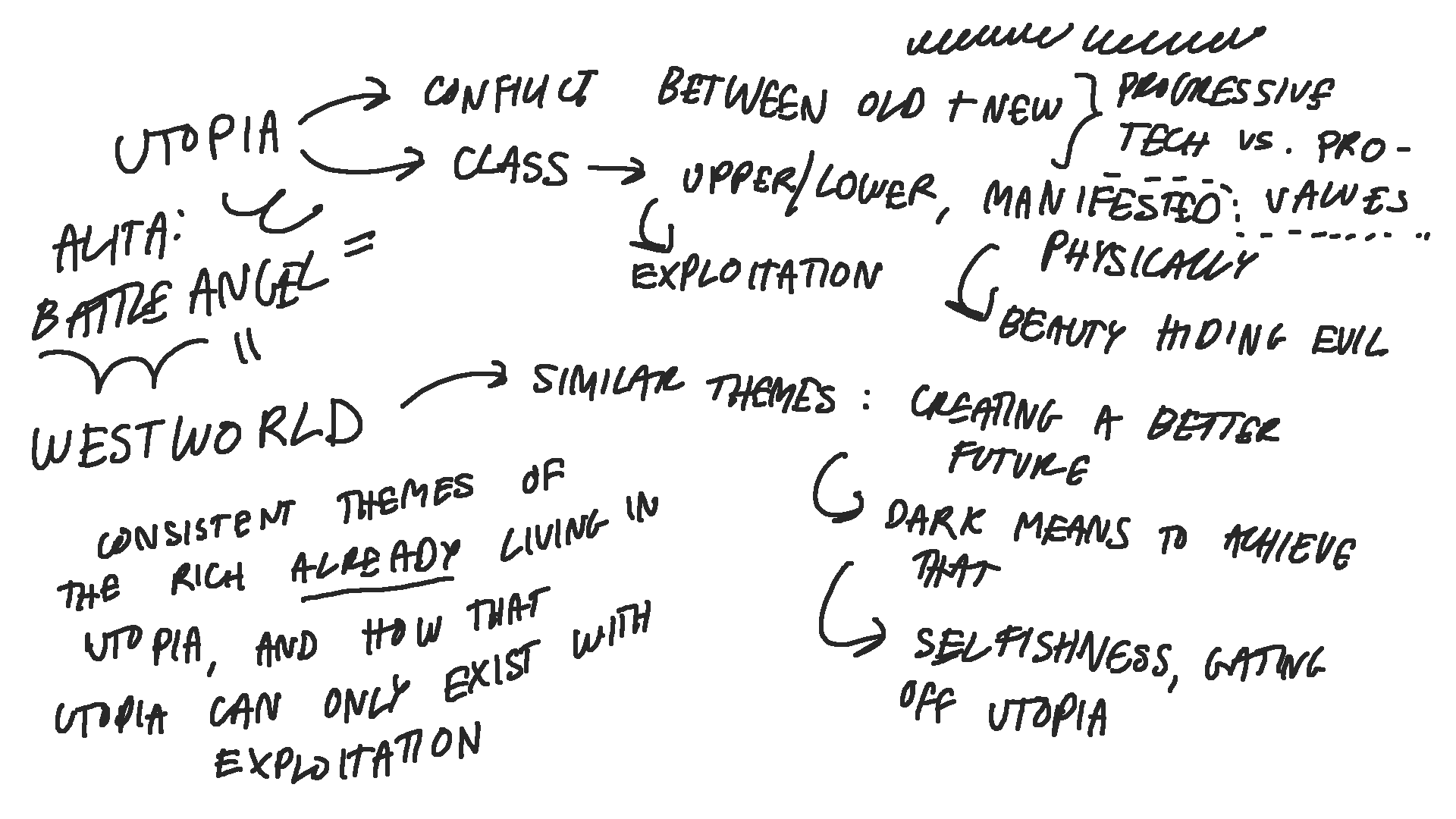
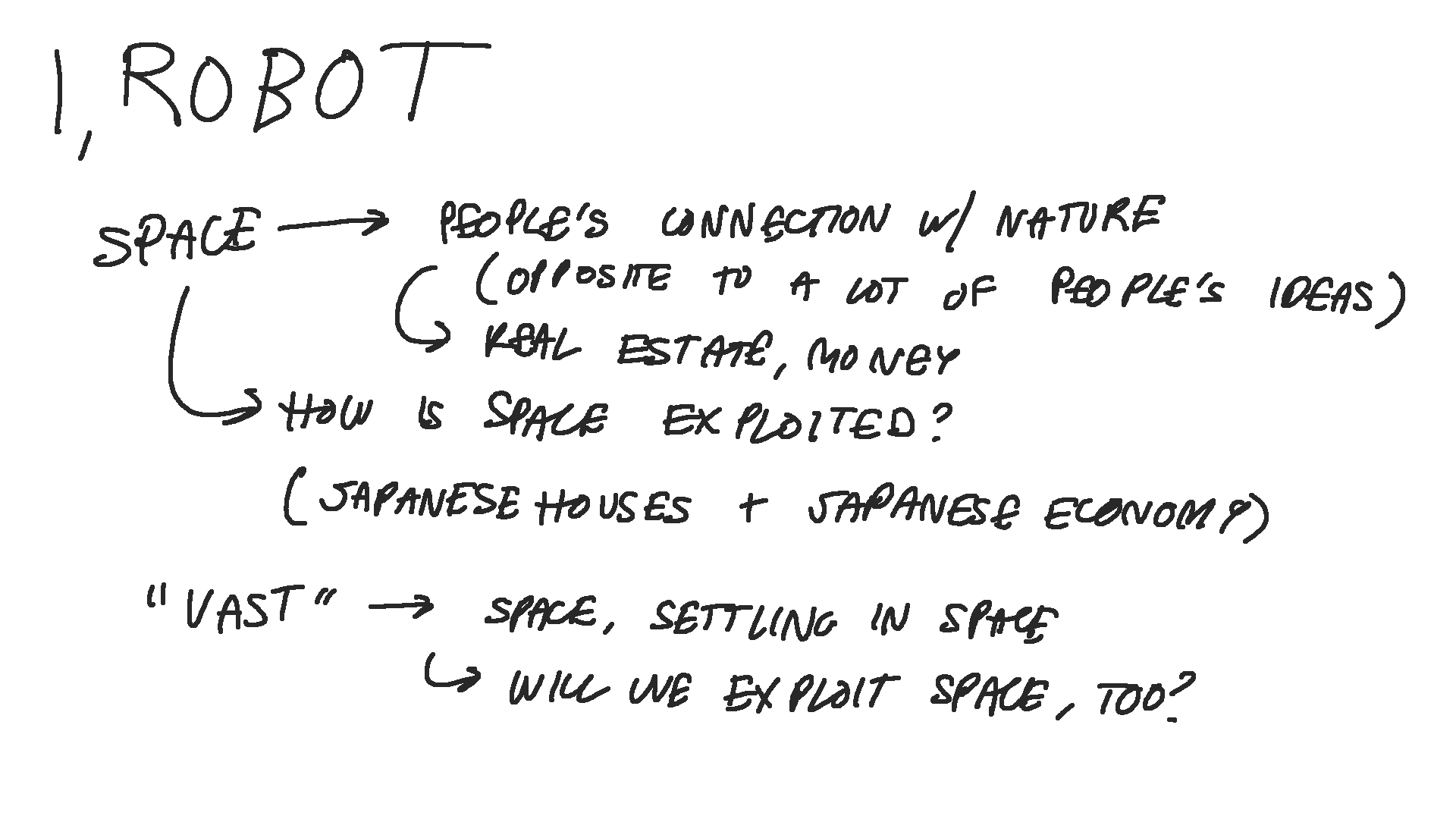
People around me probably notice that I bring anti-capitalism into things a lot. I do, it's an issue that's incredibly important to me, and I see my art as a place where I can explore anticapitalist ideas and worlds. For me, anti-capitalism is kind of one of those things that one day, you notice, and then for the rest of your life you can't stop noticing, and it... fills me with a lot of feelings. Mostly anger and frustration, sometimes pessimissim, but I try and use my art to keep hope.
Our next task was to recieve two worldbuilding questions, one exterior, one interior, and respond to them in words and visually.
INTERIOR: How will people communicate with each other?
I liked this question, because I had a vague idea of interpreting interior and exterior slightly differently, as the interior mind and the exterior body. My research and thoughts so far have been very philosophical, and very about interpersonal stuff, so I think this fits well. Since my world is about blending and trancending boundaries, I thought of ways humans could communicate that wasn't divided or exclusive - hiveminds where everyone can connect and hear each other, cabling people together and freely sharing thoughts, and being able to communicate with everything, including perhaps traditionally non-sentient things. I also did some small sketches, building some iconography off these ideas - I've been enjoying the symmetry tool on Photoshop lately, and wanted to play around with joined human forms, and abstracted ones.
EXTERIOR: What will be cheap? What will be rare and expensive?
I had quite a knee-jerk response to this question, as my world is all about what interactions with robots would be like without the power of capital and exploitation, but it then got me thinking - without that power of exploitation, there would be less production, what would be hard to produce and how would the world get around that? My ideas were that almost everything would be reused or have multiple uses, and maybe items would be able to shapeshift or adapt to fit the needs of many people and many uses. Systems of production would be far more localised, and people would also probably have to do multiple jobs/have multiple skills to keep things running smoothly. (I ran out of time to write all of this and draw, because I misread the timings.)
For the next task, we had to pick and develop an image based on our notes. I was really compelled by some of the sketches I drew for the interior question, so I decided to develop one a bit, aiming to show how technology (cabling) and humanity (brain/flesh) can interface and meld.

I next got Leon's drawing:
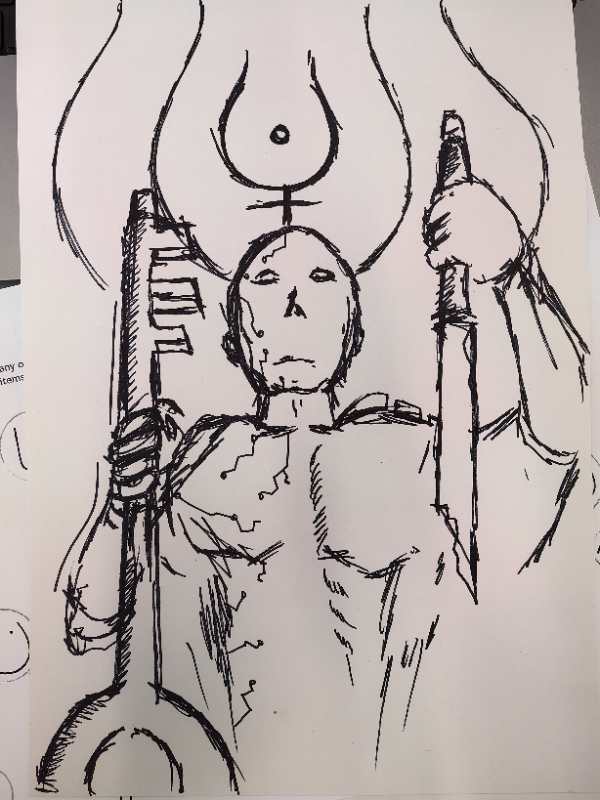
Leon's drawing
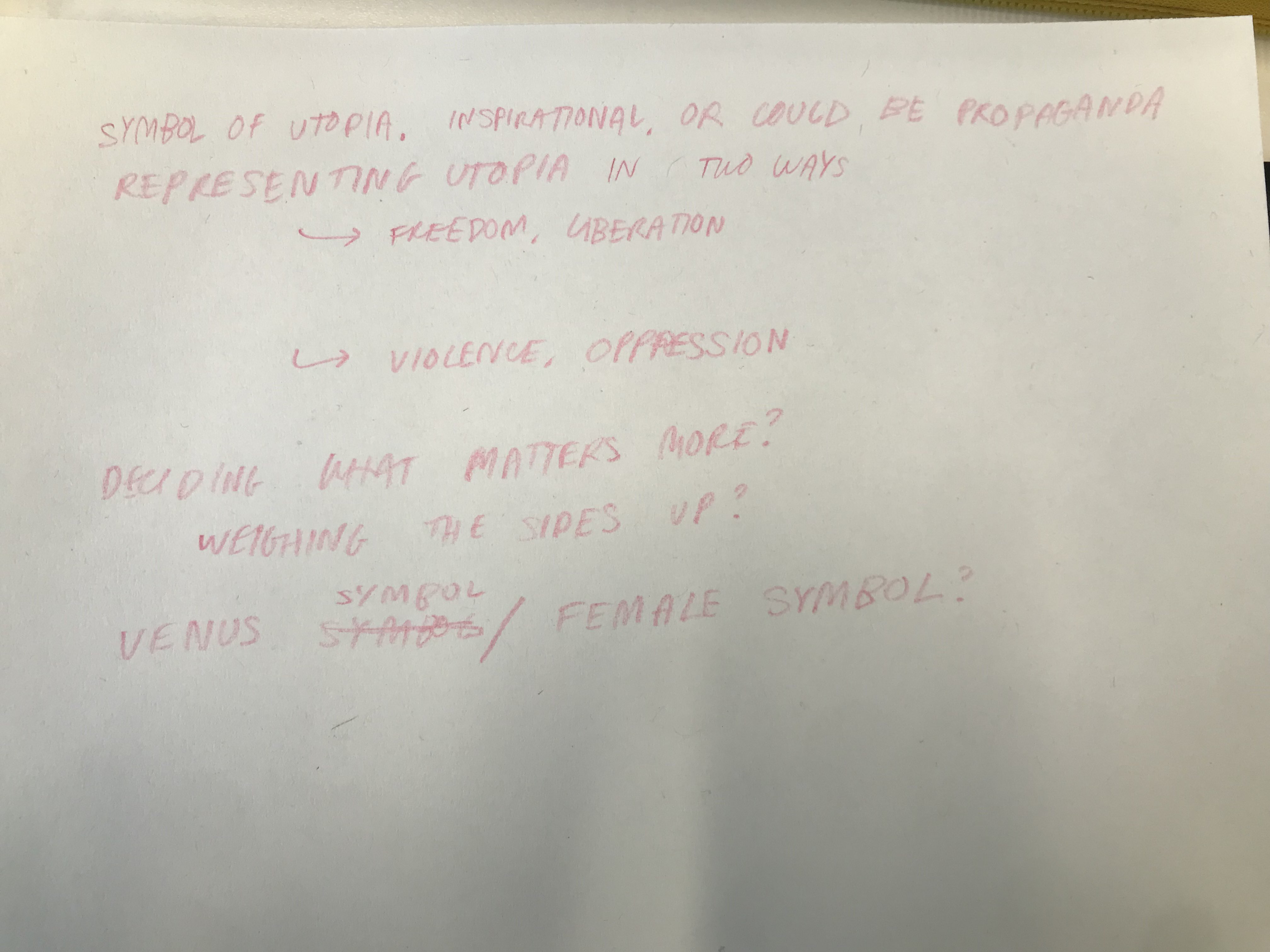
My interpretation
I then got Leon's writing of Yuka's drawing, and interpreted it like this:
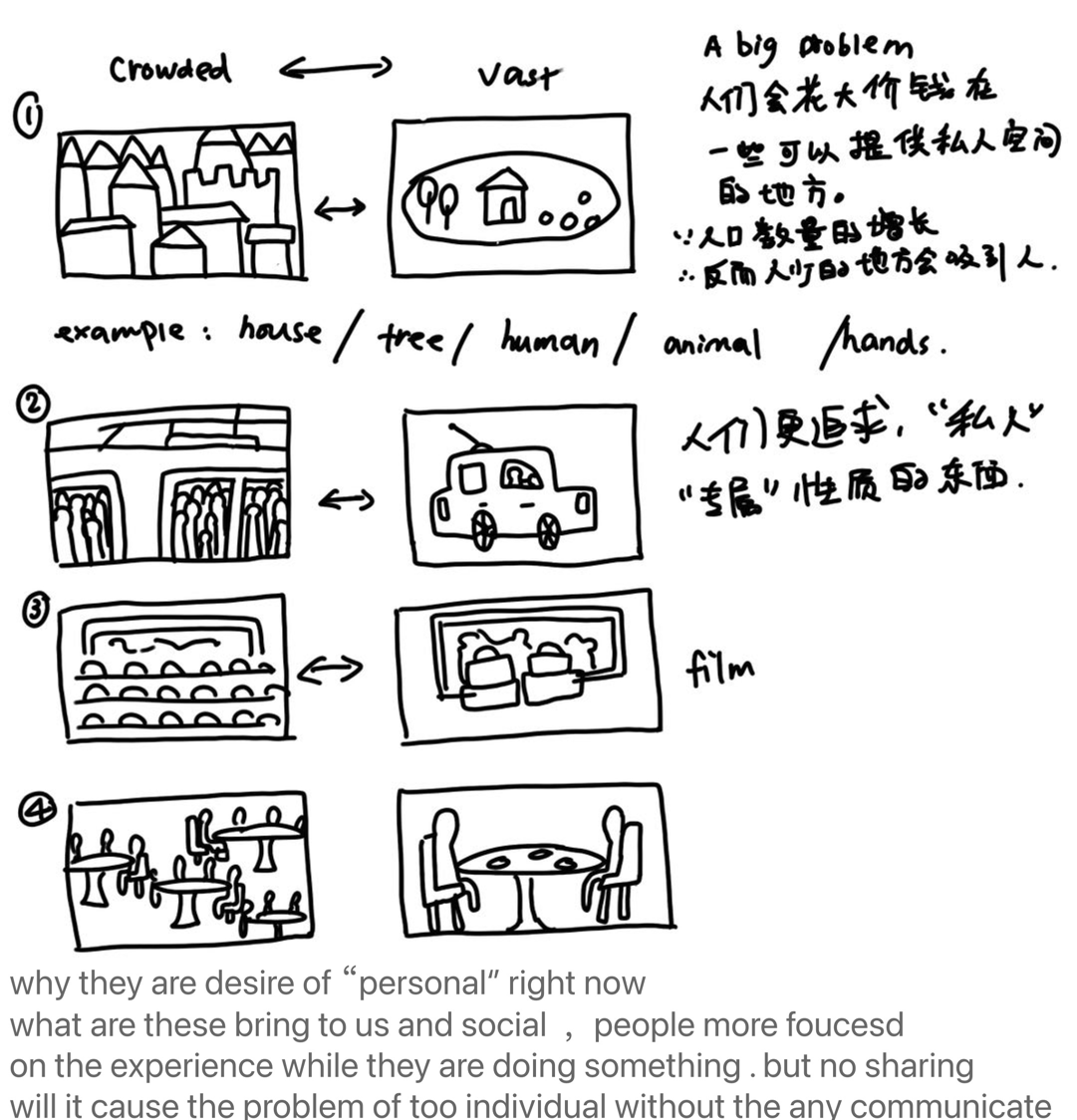
Yuka's drawings with Leon's notes
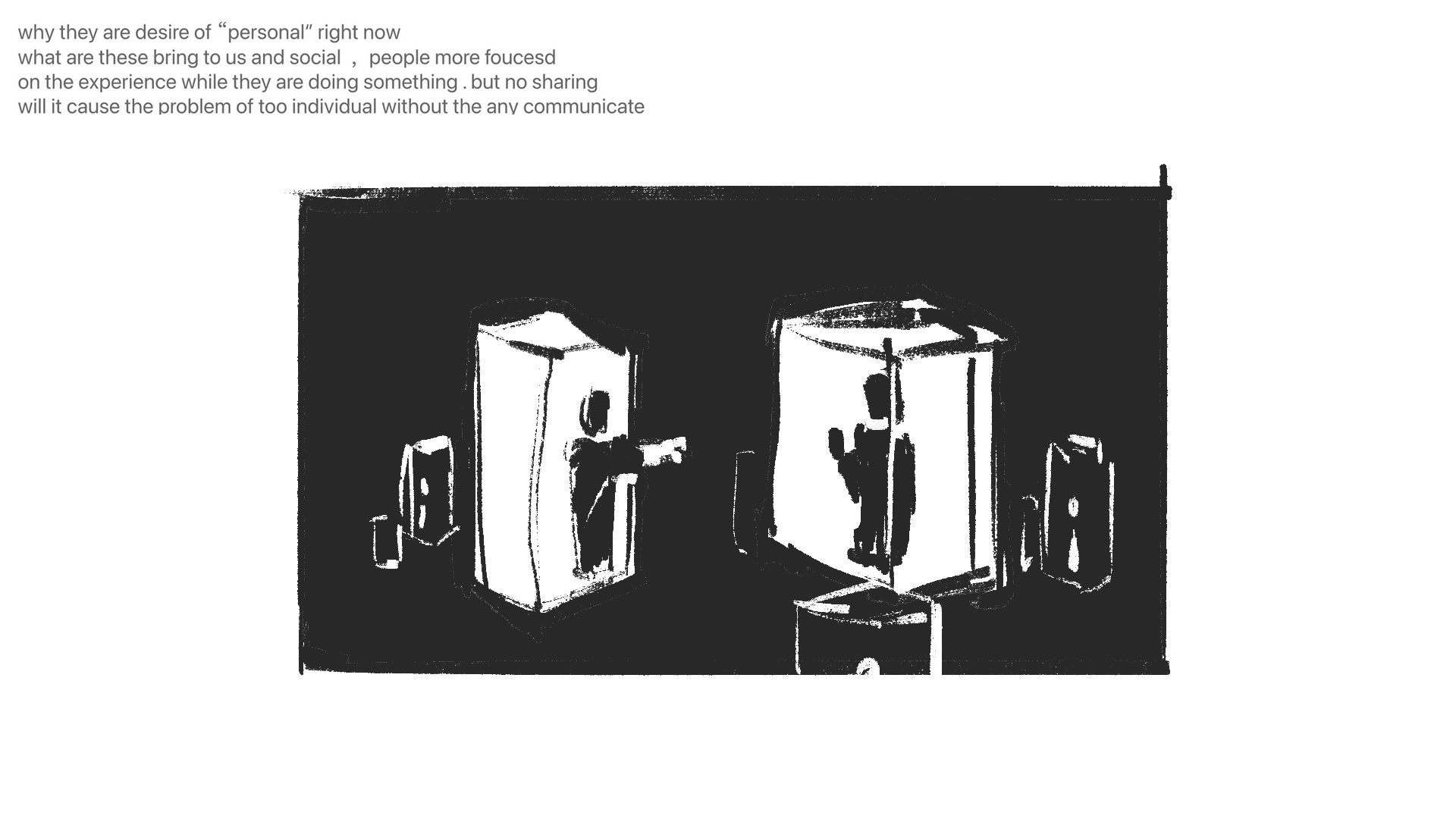
My interpretations
I then got Leon's drawing of Yuka's description back to me. I'm intruiged by how the final drawing is a lot more confrontational than communicative, I think it does show how we typically think of robots and humans, and the conflict between the natural and the artificial - the human side of the drawing seems to depict violence and the natural world, and the robotic side depicts something more luxurious but also serving. I think the different expressions on the faces might not have helped the message of communication get across, it does frame them as different and opposing.
Our next task was creating some kind of moodboard. This is a very disparate collection of images and concepts, but I think it represents a variety of different interactions and conceptions of the robotic and human, as well as some visual inspiration. I found some of these images through ARTstor, or from artist websites. Minor notes: I picked the top left computer chip image because I liked it as an example of the symmetry I'd been playing with earlier. The two robot costumes in the top right are from a robot costume idol band and from a movie from 1998; I like their uncanniness and how they also show the human inside while being distinctly robotic. The bottom costumes are part of the Future Ancestral Technologies art project by Cannupa Hanska Luger, a series of artworks imagining a Native American science fiction future, which I like in terms of the forms and style, and as an example of speculative worldbuilding.
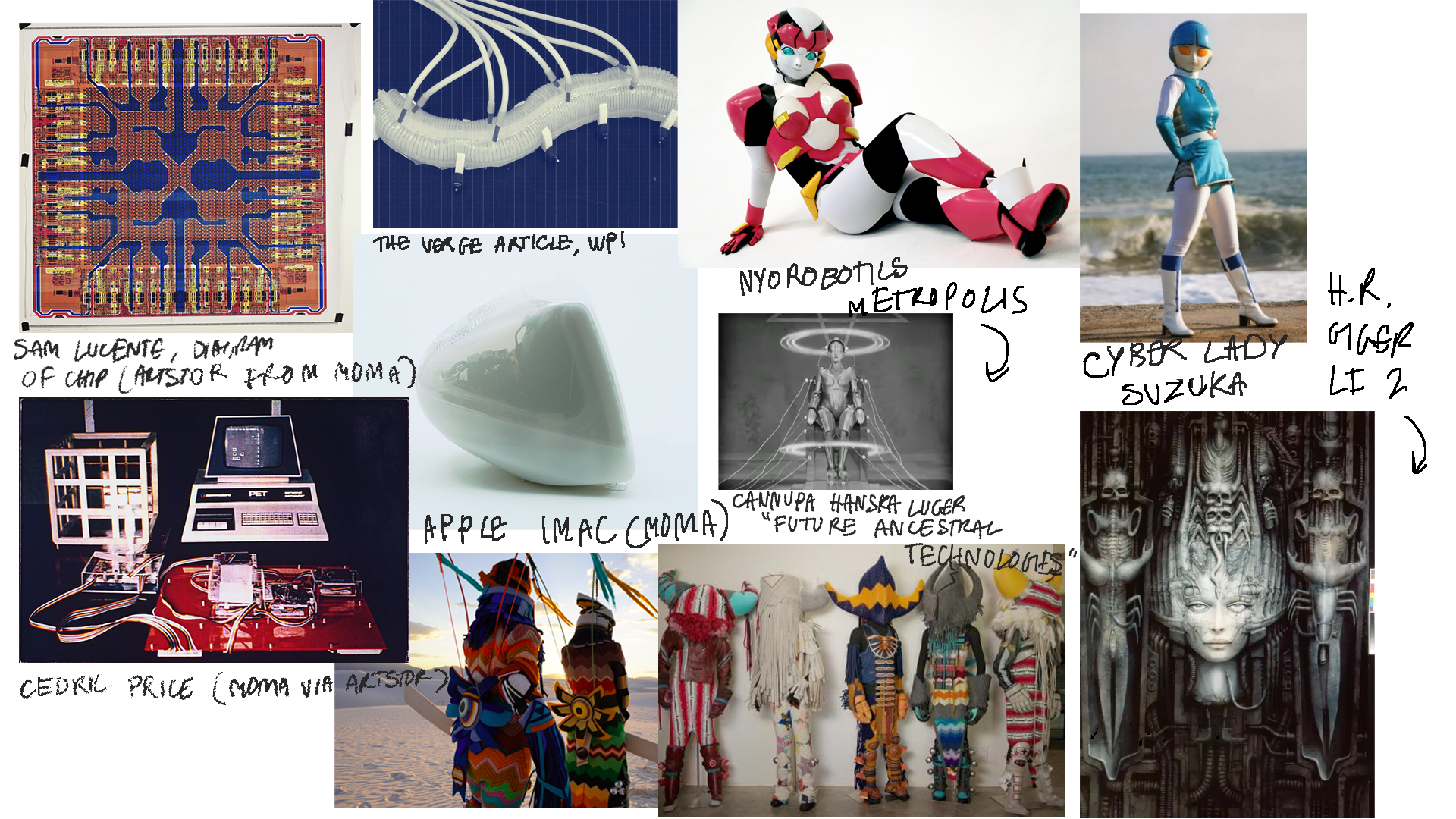
In studio, I wasn't able to connect to do the AI generation tasks, however I'm going to do some research that will explore the ethical angle later.
I found this session really helpful. I still feel like my concept is strong, and I'm excited to explore it further. My next steps: I'd like to gather some more visual references - I've got a great amount of thematic/conceptual references, which I think will make my piece more impactful, but I'd like to explore other artists and their processes.
I also enjoyed the worldbuilding tasks. Following on from the previous paragraph, I've been focusing on stuff that's very interpersonal, so I don't really have a world as much as I have an ethos, so I'd like to think more about what kind of world this actually is. I think I'm going to do that by responding to some of the other worldbuilding questions we were given.
Wednesday 10th Jan [written 10th Jan]The presentation on Tuesday included screenshots from a project by Universal Everything called Maison Autonome. I was really compelled by the visuals of this, so I decided to research it more.
Universal Everything was founded by Matt Pyke in 2004 as a self-styled collective, and it's always been working with technology and the newer, odder side of design, from when it started with collaborators working together on the internet. In the past few years, as many creatives have, they've began to work with artifical intelligence and generative algorithms.
Maison Autonome is a project that uses generative AI to create a theoretically infinite series of model-esque figures that walk towards the camera, each a sci-fi abstraction of the human body with a mix of textures, forms, and their own walk cycle. I'm super drawn to the visuals of this and the ways the body has been abstracted and reimagined. There's a variety in synthetic-appearing textures over the generated characters which I enjoy, especially the soft ones, I wanted to research soft-body robotics over the holiday, but didn't get much of a chance, it really enthralls me as an alternative to the hard, purposeful designs we see now (although I think there's a lot of potential in reclaiming that hardness.) I definitely want to explore abstracting and distorting the human form in my own work, inspired by this project. Each one seems to have their own character, which makes human/robot connection possible.
Another Universal Everything project I really enjoyed is Future You, a body tracking installation created for the Barbican's 'AI: More Than Human' exhibition in 2019. In Future You, an at first rudimentary simulated robotic construction on a screen tracks and mimics a participant's movements in an abstracted way. As time goes on, it evolves and becomes more complex in stages, being able to more accurately mimic the participant's movements. The robotic structures are generated from materials and structures and tracking schemes created by the designers at Universal Everything. I think Future You offers a compelling ground for robot/human interaction - we can see ourselves in these robots, connect to them. Even with how abstracted the robots are, people still connect and meld boundaries there.
On Universal Everything's website, I'm really interested by the progress and process stuff they've shown. How the body is abstracted in Future You is planned out, drawing from existing industrial robots, and leads to very compelling abstraction. However, no behind-the-scenes content for Maison Autonome seems to be published anywhere. I'm not sure that's because it's machine learning generated (there must be training data, though) or because it just hasn't been published. It's frustrating, because I'm really fascinated with how Maison Autonome's figures abstract the body, and I'd be really interested in what data or methods they used to get that result.
I don't have, on the surface, an issue with machine learning generated art or AI art. I think if you're training data ethically then there's nothing strictly bad happening, and I don't think you can make a material distinction between AI art and human-made art that doesn't exclude a lot of other things. My view of art has always been that art is infinite and interpretative, anything can be art, so it doesn't make sense for me to object to AI art if it's done well, really. There are things that frustrate me about it, though. Like with Maison Autonome, a lot of AI art doesn't have a process, and I personally find the creative process really interesting. I like Future You because the use of generative algorithms is preceded with a bunch of thought out ideas and exploration, and I'm interested in the decisions they made, but Maison Autonome, for whatever reason, doesn't have that, and it means I feel less able to analyse and connect with the art. I also think people, for that reason and others, do resonate more with human art, because of a desire for human connection and human experience, and also because human art can far better contain symbolism and meaning than AI art.
Using methods to abstract the human body to create new robots to explore communication and breaking down boundaries will be my next step in this project.
Sources used:
Maison Autonome's page on Universal Everything's websiteFuture You's page on Universal Everything's website
Interview with Matt Pyke (founder of Universal Everything) from It's Nice That Thurs 11th Jan
I was talking with my dad in the morning about this project (he works in sustainability and environmentalism) and when I mentioned my project and its focus on blurring boundaries, he brought up how my project could incorporate the environment. Donna Haraway in the Cyborg Manifesto mentions how technological advancements and robots can bring humans and nature together by degrading the line between what is animal or human, and creating new heirachies. Amy M. Youngs, in Art and Robots, uses robots to reframe our relationship with the natural world and make ourselves part of flourishing ecosystems, based on this idea that capitalist technology and industrialism has portrayed nature and the world as something we are seperate from and to exploit. My idea is, in my world where relationships are non-heirachical, that encourages communication and sharing, what would our relationship with nature be like?
Building from our discussions about methods on Tuesday, I wanted to create my own methodology for designing robots, inspired by the Maison Autonome project. I liked the idea of robots breaking down boundaries between people and communities, and the idea of compound and melded experiences. I drew some little figures, and proceeded to push them together and overlay them over themselves to create new forms. I then used the shapes and contours of these figures to design new, abstract robots. This was an engaging process, and gave me some really fascinating visual stimuli to build from for the interior piece. My interior artwork will be more about the interior of the mind than it is about a physical interior.
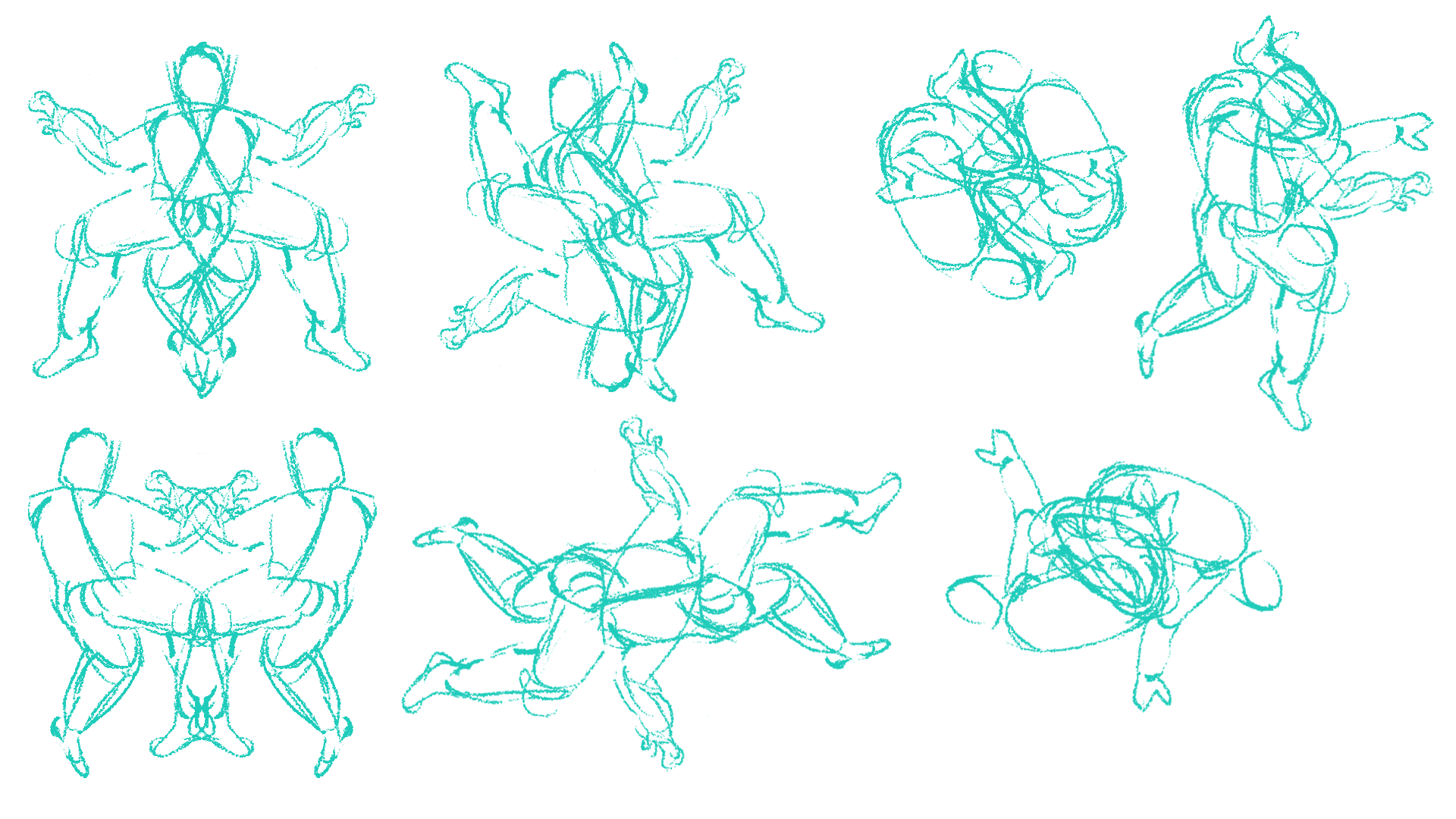

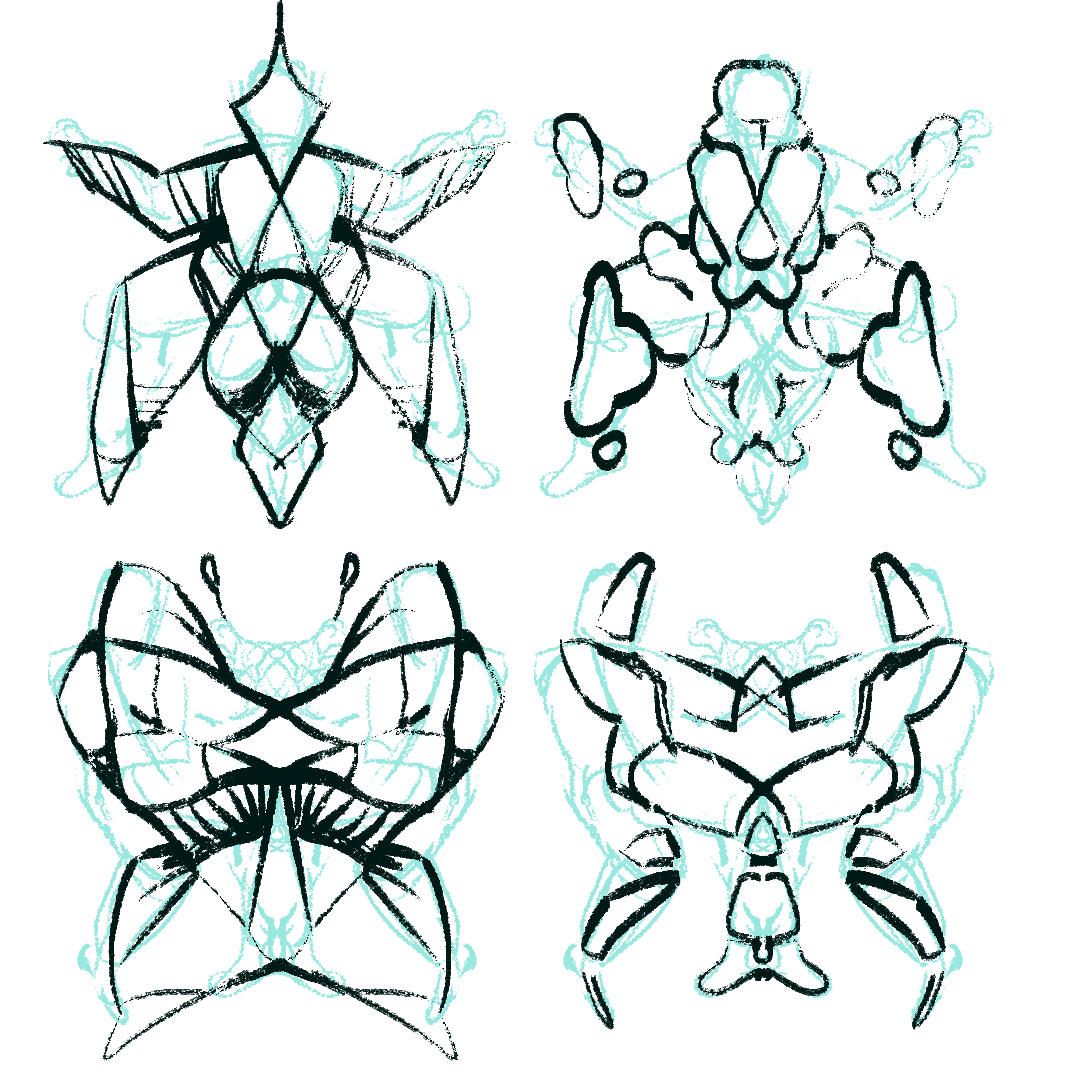
My first tries (on the left) didn't feel so visually successful - I think I was focusing too hard on the actual human form and overcomplicating it a bit. I then tried to focus on contours and lines of action as opposed to actual human shapes (on the right) and cycling through different methods (using lines, using soft shapes, using rectangles), and I think that came out super successful.
I also looked at Jess Johnson's work. I love the psychedelic style of her art (I'm somewhat of a fan of prog/psychedelic music so I liked the vibes) and how she also uses melded bodies and symmetry. I also took notes on her colour schemes, she tends to use colours of very different hues but with similar values, combined with black and grey. I like how she can pull off 'odd' colour schemes, through colour choices and also through the nature of her work. It's definitely something to keep in mind, since I've been struggling with colours recently.
Friday 12th FebIn studio, before my tutorial, I worked on ideas for the exterior artwork, expanding on the conversation I had with my dad. My idea was, roughly, that in a world without exploitative relationships, the plants and animals we farm and support would be included in a structure of symbiosis, and that in some way they'd be able to actualise their wants and needs, and people could communicate with them. Inspired by Embassytown, my favourite book, where factories and infrastructure are all massive animals, I started sketching a farm that could be its own creature. I was also very inspired by Amy M. Youngs's work about redefining humanity's place in the ecosystem, and visually drew from some of her hydroponic artworks.
I then had my tutorial! I got a really positive response to my work, and got directed to some really interesting references. I mentioned that I was struggling with visually representing my ideas, and Eleni gave me the pointer to create a gallery of my visual references. Concepts of object oriented ontology and indigeniety were brought up in relation to my work, which are interesting and relevant but I haven't had time to research. People in the tutorial also asked some interesting worldbuilding questions, like where this is located, what lives in this environment, or what multipurpose uses everything has. It was a helpful tutorial and I enjoy talking about and seeing other people's work.
Building from Eleni's advice, in order to make some headway into my pieces, I brought together visual inspiration for my interior image. An artist reference Eleni brought up for someone else in my tutorial was the interactive installations of Baum & Leahy, and I found the textures and otherworldly imagery inspiring - I particularly liked their Sensory Cellumonials exhibition and how it used abstraction and colour to create a really immersive experience.
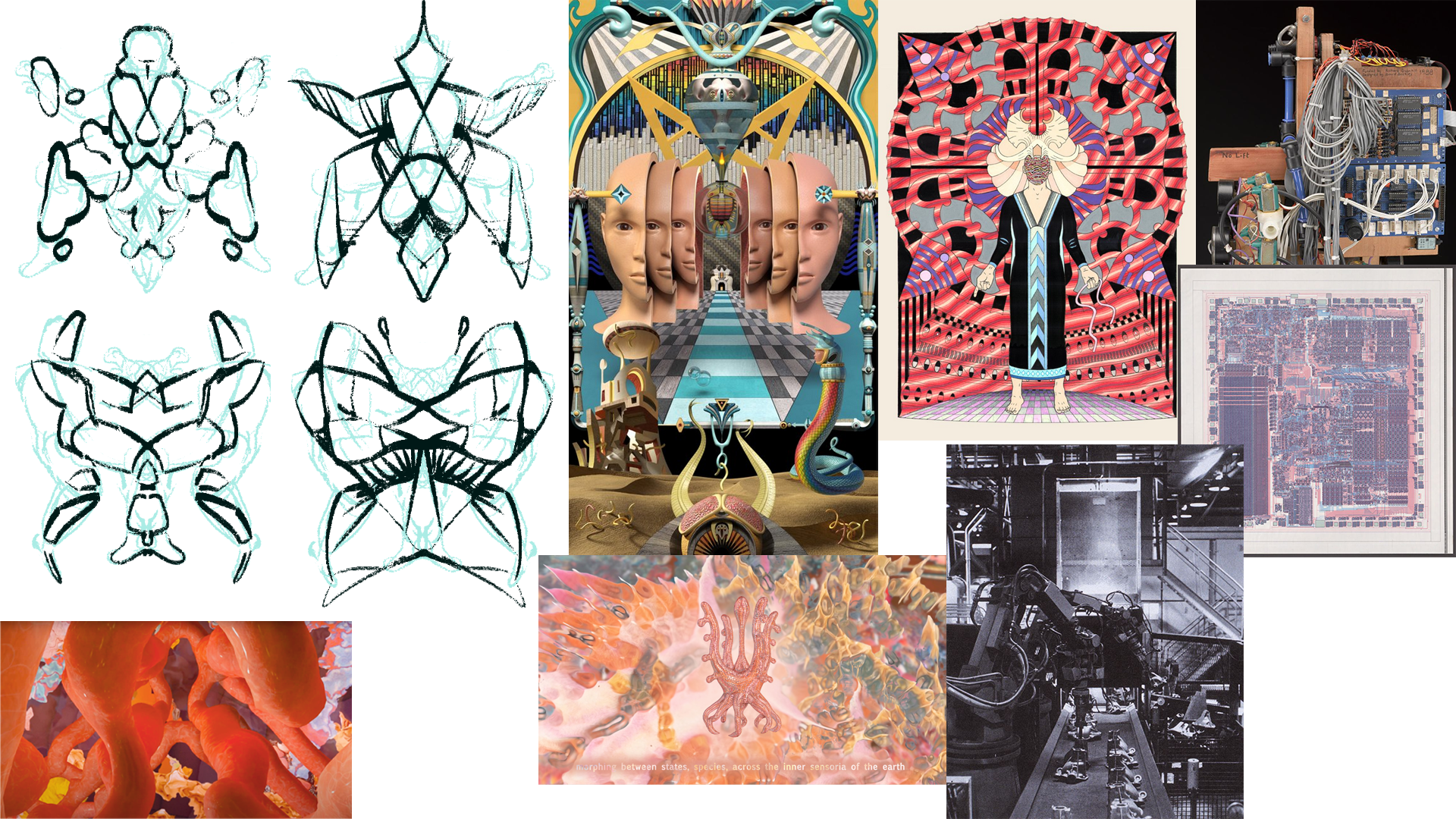
Week 13
Monday 15th Jan
Building on the abstracted robot forms I made last week, I started thumbnailing my interior piece. I've kind of accepted I'm not getting a properly finished piece by Friday, but I want to at least get a sketch with planned-out colours. I wanted to have three forms showing robot and human interaction, melding, and becoming a new being. I went back and forth a while on the composition, whether it should focus centrally or move left-to-right. I also experimented with a more metaphorical interior (upper sketches) or a more physical interior space. As I've drawn a lot of pairs, I drew that circle of people at the bottom, to create a whole community merging together.
I then put a moodboard together for the exterior piece, and began the thumbnailing process on that. I had a bit less visually to draw from for this piece, as I didn't do much artist research for it—probably why I struggled with putting it together quite a lot (and my inexperience with backgrounds.) I did a bit more sketching to establish some worldbuilding for this piece, and then got into thumbnailing. I wanted to, with the wind-chimes, show how creating art and music in this world is utopian and accessible, but it's a bit hard to pick up on, and also respond to Eleni's worldbuilding question about what other purposes do these living greenhouses have.

I think these thumbnails (for both pieces) are strong, but I'm really struggling with what I'm going to do with them stylistically. Sci-fi feels like it often befits smooth, shiny and clean work, but I've been really enjoying the scratchy brushes I've been using recently. Other than that, with colour or just in general what I'm going for, I'm feeling really stumped.
Tuesday 16th JanSurprise group work! This introduction of this new element of the project (one that, if I recall correctly, we weren't briefed on before) definitely threw me off and stressed me out. Still, I tried to get the most out of it. Everyone in my group had quite different ideas and interpretations, so it took a long time for us to figure out basic things like our theme and title, let alone a cover image. That wasn't helped by the fact we had a couple of group members who weren't really talking or pitching in with ideas.
We put all of our work into Miro, since it was the most visually interesting to us and easy to learn to use (we found Artspaces and a book-styke PDF too restrictive on form). Eventually we arrived at the point of framing our digital exhibition as 5 different explorations of utopia, and we would then connect them back together with identifying which ones link to each other with themes and ideas. We would format our exhibition with a central cover and branching paths. We named our exhibition Wandering and Wondering, as we think it captures our different perspectives, and decided to colour code our work to make each piece distinct. We then based our cover off that colour coding.
I also talked to Eleni and some friends in class about my previous issue of not knowing what to do with my pieces beyond the sketch. I was originally considering not colouring them, just doing the lines for the sake of ease and not knowing what to do, but Eleni successfully pursuaded me to colour them, since colour is such a good tool for establishing mood. I want to keep going with the scratchy, textured lines, and with textured colouring too in a coloured-pencil style. As for the colours, I want to pick ethereal, calming ones, to emphasize that this is a world of happiness and connection. For the interior piece, I'm thinking white, pink and purple, as those to me seem ethereal and magical, and for the interior blues and greens with pops of white in a calming colour scheme.
Here are the thumbnails I settled on. For the interior, the circular background of the first but with the computer/flesh fusion background surrounding that. For the exterior, the version with the wind chimes at the front (there was also a version with a robotic figure at the front, but I decided that might complicate things too much. I still don't feel fully visualised but I've got enough ideas now.
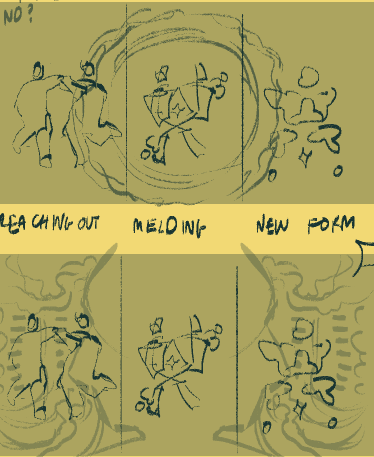

From home, I developed my chosen thumbnails into sketches. I like doing really detailed pieces, so I tried to create a nice balance of detail across the pieces. This will be helped by line weight and colouring the lines when I get round to that. I'm really enjoying these, even if I don't think I'll be able to fully complete them in time.
I also then did a very rough pass of colour under the sketches, to make sure the colours are coordinated and work well before I get into the clean colouring. I did this with the help of creating a gradient I liked and picking from that (roughly.) Usually when I colour something I pay a lot of attention to having a wide range of values, but I kind of enjoy the flatter look here, it does lend a dreamlike feeling.
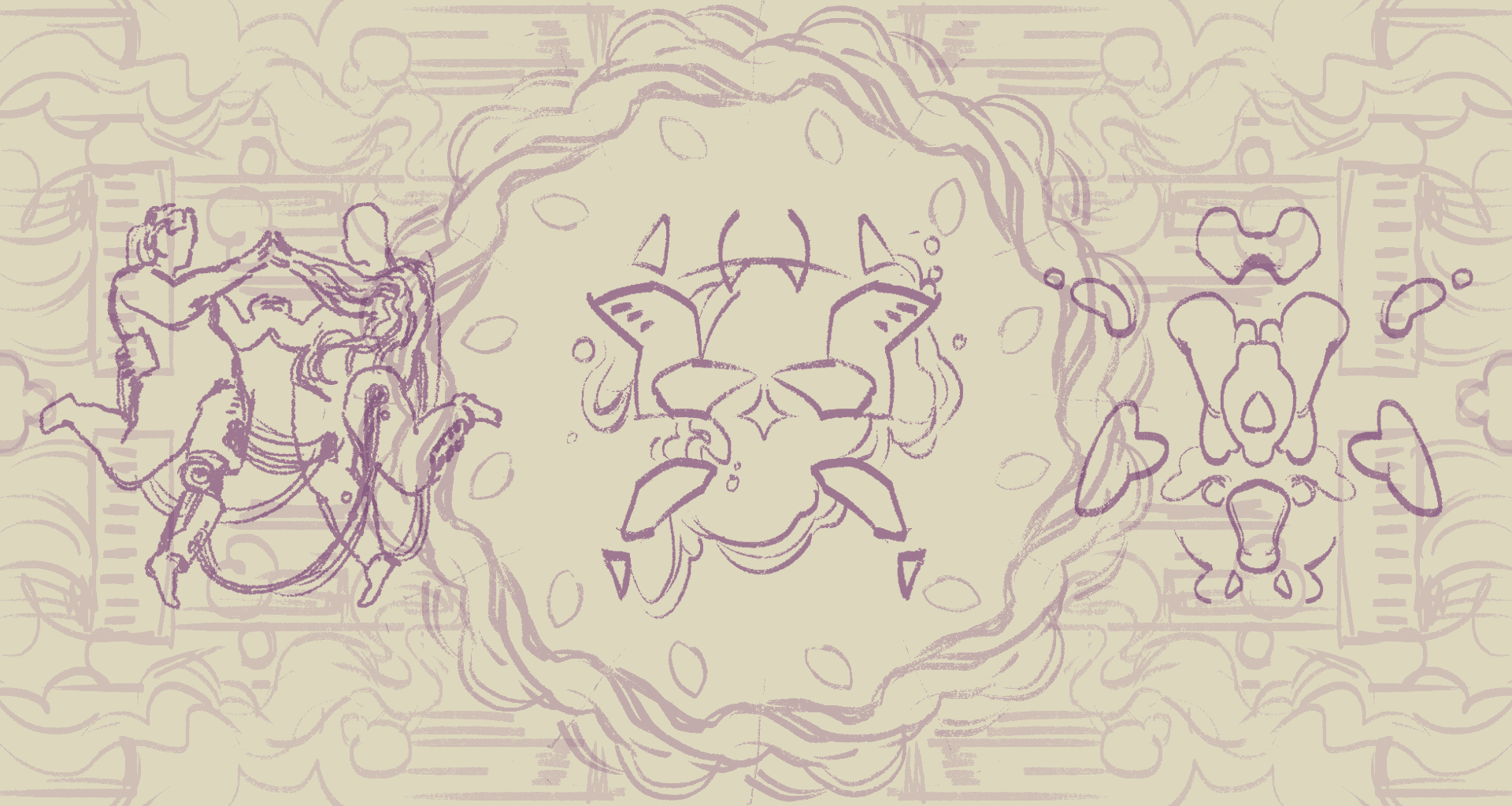
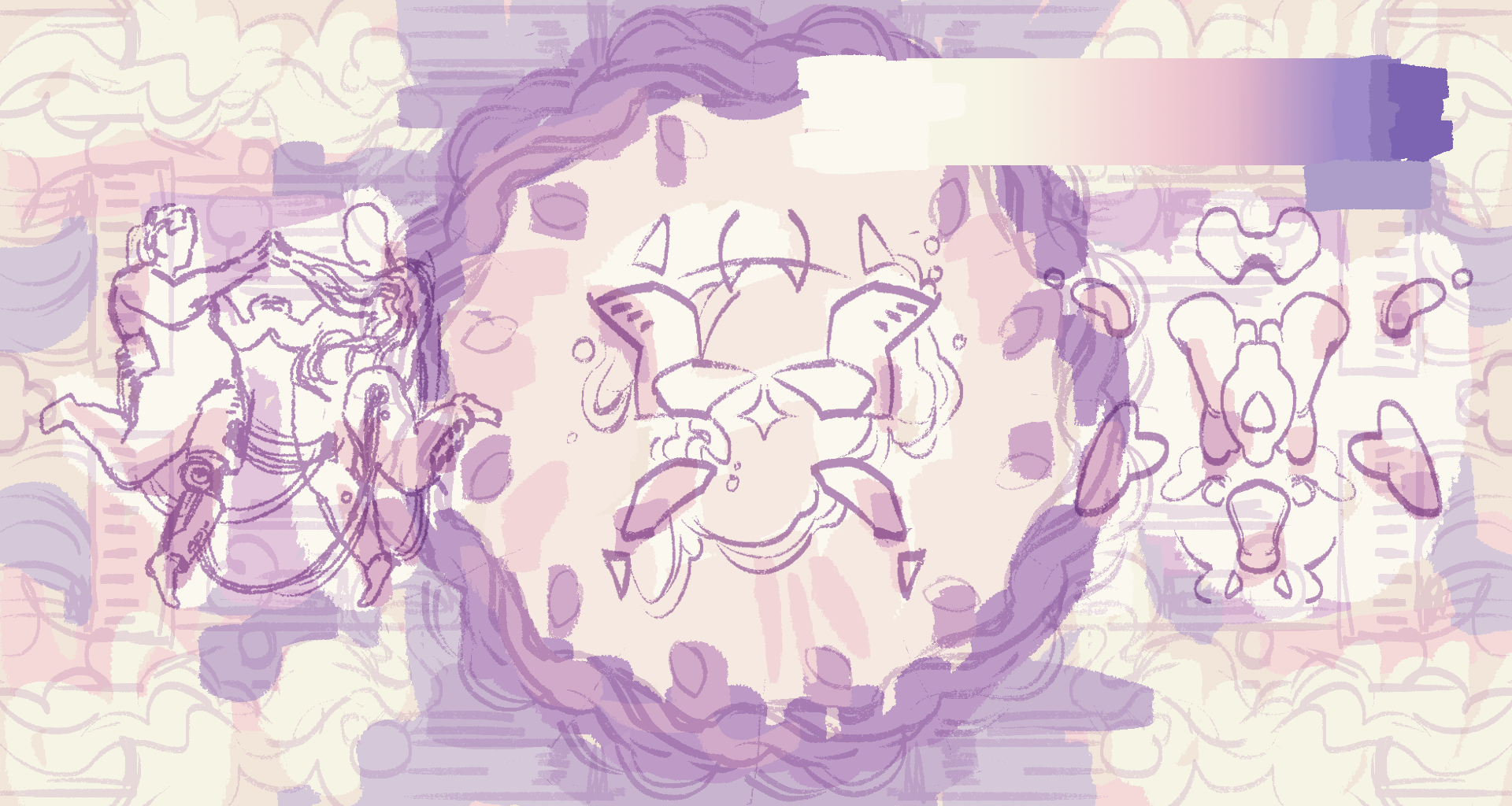

 Thursday 18th Jan
Thursday 18th Jan
With one day left until the exhibition, I decided to simply ink the pieces and call that done for now - it's not too much more work, so I can still get my work on the Miro board done, and it's clear what my intentions are but also easily editable if I want to respond to criticism.
Here are my currently finished pieces! The background on the interior was going to be more painterly, so I decided not to line it now.
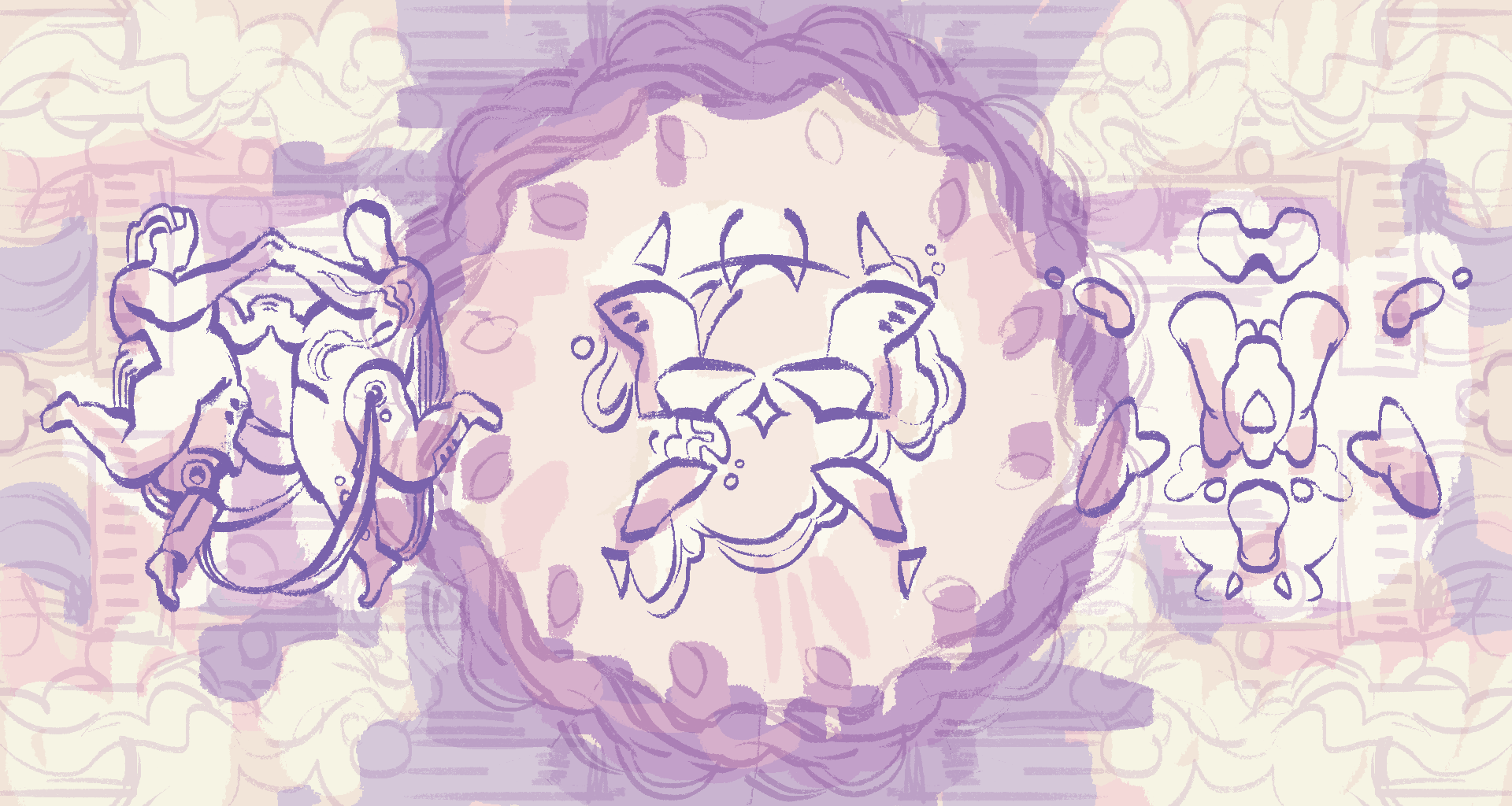

You can view our exhibition Miro board here.
In the exhibition, I chose to use minimal captions that let the work shine, and have them be comparatively small. I also wanted them to have a bit of poetic flavour to them and try and reflect the psychedelic and free scenes in my images.
Description: I have explored history, perspectives and art on robots, artificial intelligences and machines to imagine a world where our relationships with robots and other non-humans are not based on hierarchy and exploitation. This world allows for a radical breakdown of boundaries, creating an interwoven, interdependent, embodied dream.

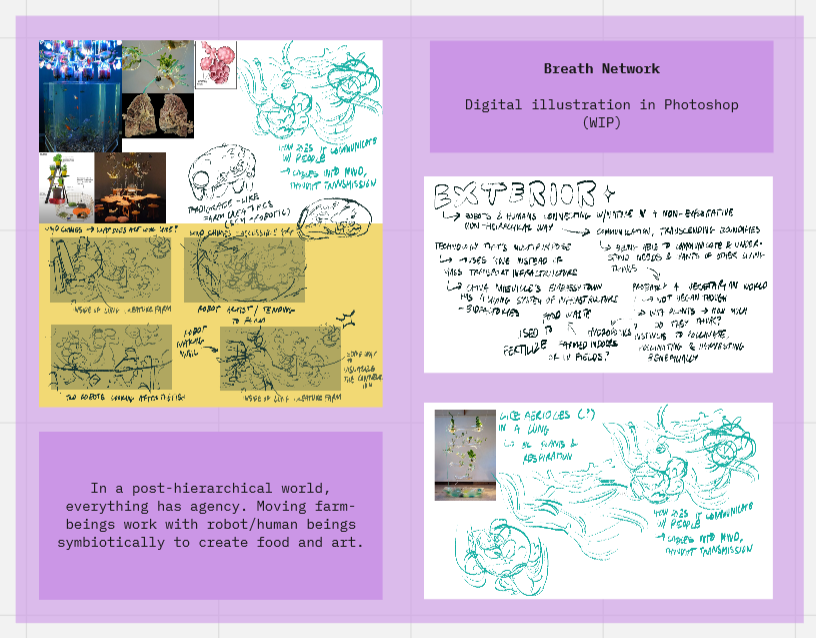
I enjoyed the criticism workshop, even when having experience in crit - it put things into words for me and helped me for the rest of the session. I have some of my drawings from the crit session, some others got put up on the wall & I don't think I got them back! Here's some of mine:
For the criticism workshop, we were given the Idealand group's work viewable here. We decided to all write individual critique of each artist and the presentation as a whole, then chat about our thoughts to build on our ideas. That way, each artist would recieve multiple viewpoints and lots of critique. Here's the critique I provided.
Critique for Idealand
Overall
- Layout ties everything together very well, cohesive and whimsical
- I like the premise of connecting the artists together, but I don’t quite understand what the lines convey - is it stylistic similarities, a journey, etc? No beginning marker makes it confusing to navigate
- Artwork feels very small, have to zoom in a lot to see - first thing you notice is the writing
Florence
- Love the colour choices - they convey this feeling of safety and peace. The detail and texture in the rendering really emphasises this
- What does the dome protect this world and the people in it from?
- All of the attention to detail in the rendering of the foreground (the blankets, the landscape) make the sky feel very empty, despite taking up a lot of space in both pieces. This works to draw attention to the foreground, but it also makes the sky feel imposing, but also slightly like empty space. Was keeping the sky as simple as it is an intentional effect? What was the intention?
- Very similar perspectives, very similar compositions. A differently composed and further piece could give the viewer a better sense of the whole of this world
Avery/Guo Chen
- The consistency in colour and style between the artworks makes them fit together and feel like parts of a story.
- Stylized faces and cartoon imagery are very well pulled off
- On the outside piece, the white background in the top left draws my eyes away from the rest of the piece and pulls me away from the focal points
- What’s the context to the bears? What do they symbolise? To me, they come off as sweet and whimsical against the darker themes
- Black and red colour scheme, blank faces of characters give the interior image a more serious and sad feel
Julia
- I love how you’ve brought in analogue elements with the newspaper. It’s really unique and makes your piece stand out
- What does your utopia represent?
- Good use of photobashing, I like the almost 3D brush texture on the bottom.
- Use of photos creates this journey of stepping into another world
- In your interior piece, you include foreground/midground/background elements, giving a sense of layering and depth, but there isn’t a focal point or visual hierarchy or flow, so my eye isn’t being guided anywhere
Iyron
- You’ve put tons of thought into your concept and I enjoyed reading a description of your world. I like the inclusion of social issues
- Texture and rendering in the first image is done very well, love the space background. Planets have distinct textures, which makes them more identifiable beyond just colour
- This might change after both pieces are finished, but both look quite similar (same colour scheme, same elements, different composition.) It means we got a narrow view of the world, when I’d really like to see more to match the care you’ve put into worldbuilding
- External artwork has a dynamic composition, but the internal one has less direction and flow. It feels very static and a more dynamic composition could be more immersive and tell more about this world
- How do people on the three planets live? What other knock-on effects would the different levels of water cause for people? Because the images are so similar, there’s so much unexplored
Yu Lam
- Super distinctive art style, and impressive use of Illustrator. You use lines sparingly for emphasis very well
- Colours are playful. Using a very wide colour scheme in the first and sticking to smaller colour schemes in the second makes the pieces flow while feeling distinct.
- The first piece includes perspective and depth, but the second piece contains only straight-on flat perspective. This perspective works for your second piece, but I’d like to see the same concepts explored with different compositions to flow more and express different feelings
- Very communicative, easy to grasp
- Your notes are so well researched and detailed, and have really interesting compositions and ideas. The thumbnailing process has helped you develop your ideas. Development process super thorough and considered
- Strong colour scheme and textures
- I feel like there’s a jump in colour, theme, idea from your development to final images, they’re interesting alone but next to your development I feel like I’m missing something. Perhaps some writing could help explain what you’re saying?
- I really like the fire/hand avatar characters
I liked talking to my teammates about critique we gave, & hearing people's different interpretations of pieces.
We then recieved critique from the Idealand group, us all getting one sheet of paper with a paragraph of critique on. I don't know if this was from the group as a whole, or individually (everyone seemed to get a piece of paper from one person each), but I was a little frustrated by only getting one viewpoint. More critique would have allowed me to build up a better picture of how my piece affected people and what people thought of it, since I would have had more data.
The critique I got:
The content of the picture is rich in detail, and I can see the collision between the emotional and dreamy human and rational machine. Secondly, the colour of the two paintings is harmonious, and the connection between the internal and external worlds can be felt through the branch shape of the lines. However, maybe it's just because in the draft stage, I saw a lot of ideas and details about green plants in the environment of the second painting, but it's difficult to grasp the key point in the painting, perhaps a more obvious subject is needed?
This is a good critique. I'm a little frustrated by the 'human vs machine' comment, since people interpreting my work as having humans and machines as oppositional has happened before, and it's counter to the goal of my project, which is to break down those boundaries. Because of this only being one response, I'm not sure if this is an interpretation a lot of people are getting from my art, or if it's just this one reading.
I do think their point about the second piece is correct - the pieces cohere visually (I didn't even notice the branches connection before, I did that totally subconciously!) but the thematic connection between the two is not very well represented. I think I could improve this by bringing more robotic elements into the exterior piece, so it makes this idea of melded beings more clear.
Monday 22nd JanuaryBecause I only got one piece of feedback from the initial feedback session, I reached out to coursemates on social media & wondered if they'd provide me with critique. I got some really great useful responses, and got to see more of my friends's work.
Critique from Caitlin
Your concept is really strong and interesting, you have put a lot of thought into it and it shows! I love the flow to the lines in your illustrations, it makes your utopia feel otherworldly but soft. I love the creatures you have imagined, combining an otherworldly-feeling creature from our world like a tardigrade with elements of your imagined utopia is interesting! Making this creature stand out in either illustrations would be good! I love how you have considered how elements of your world works scientifically. The colour palettes for your illustrations are pretty, the strong presence of green in the second illustration show your utopias connection to nature. Could any extra texture or patterns be added? At this stage it is a little hard to determine some of the objects and subjects in the illustrations, maybe make sure these are defined when you refine your work :)
Critique from Charlotte
I really like the composition for the sketch showing the interior space. How robots and humans meet, intertwine and reformed as something new. I especially love how you make good use of symmetry (YOUR SKECTHES NEXT TO THE REFERENCE PICS ARE SOOOO GOOD). Everything just looks so vivid and dreamy in the drawing.
For the exterior space drawing, the colour palette and composition are amaaaazing. The dark and bright colours divide the space clearly and highlighted where the main focus should be. Even though it's just a sketch, the information provided has already caught my interest and wonder what the bubble-looking thingys are for. The way you show your world-building is very effective!
Critique from Crowley
I think your ideas and research about living with robots is quite evident from your illustrations, I definitely understand that kind of relationship from just looking at it before reading what you wrote which is always impressive, to show what you wrote down visually so Clearly.
Your use of perspective on your exterior is successful and obviously you've blocked out where you want your colours to be plus what is really impressive is how you've included all this detail in a WIP without making it look messy
My only advice, other than of course finishing everything, i think it would be nice to see some similarity in terms of colour palette for both the illustrations, your interior makes your initial idea evident only by the two figures that you have drawn, I'm wondering if there's a way that you could perhaps add more that since you talked about this lack of hierarchy just to also push yourself a bit more :D
I really appreciated the extra critique I got. I think, from these extra criticisms, I can see that my ideas do come through strongly in the interior piece, but the exterior piece is lacking strong cohesion and thematic resonance. It does feel very different from the interior piece, and I enjoy the colour scheme, but I do think I'm going to need to rework some of the exterior piece, and as I said before, add more robotic/melded elements that make the communication and joining between robot, human and nature more clear.